|
|
|
|
Late Entries to a Survey of Bestiaries
The staff of the Poison Pie Publishing House assembled a survey of one hundred bestiaries, posting an entry on their blog for each day from June 1, 2016 to September 8, 2016. When they were done, there were additional bestiaries that they did not want to omit entirely. This page lists latecomers to the survey added in 2018.
|
|
|
|
|
January 6, 2018
Monstrous Compendium Ravenloft Appendices I & II
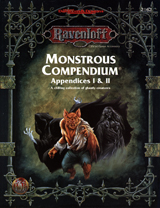 designer: William W. Connors
designer: William W. Connors
interior artists: Thomas Baxa & Mark Nelson
cover artist: Jeff Easley
publisher: TSR
publication date: 1996
cover: softcover
number of pages: 128
ISBN-10: 0-7869-0392-9
ISBN-13: 978-0-7869-0392-4
catalog number: TSR 2162
description: This compendium collects Monstrous Compendium Ravenloft Appendix I (1991) & Monstrous Compendium Ravenloft Appendix II (1993), which were originally issued as loose leaf sheets in a folder. This book contains creatures found in the gothic Ravenloft Campaign Setting. The book is compatible with Advanced Dungeons and Dragons second edition.
Our featured entry from this bestiary is the ermordenung.
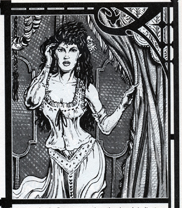 The ermordenung are a dark and evil people found almost exclusively in the domain of Borca. Here, they act as elite agents of lvana Boritsi, the ruler of that dread domain. On rare occasions, they are sent on missions outside of Borca to further the interests of their mistress.
The ermordenung are a dark and evil people found almost exclusively in the domain of Borca. Here, they act as elite agents of lvana Boritsi, the ruler of that dread domain. On rare occasions, they are sent on missions outside of Borca to further the interests of their mistress.
Ermordenung appear as normal human beings of surpassing attractiveness. The men are tall, normally no less than six feet in height, and smoothly muscled. They seem to radiate an inner power from their finely set, classical features. The women are tall, often only an inch or two shorter than the men, and have the perfect features that every artist tries to create. Both sexes are marked by raven hair and penetrating dark eyes that, it is said, are almost hypnotic. Their complexion, however, is rather more pale than that common to most of the people in Borca and contrasts greatly with their dark hair and eyes.
The ermordenung speak the common language of the people of Borca. Their dialect, however, is marked by an aristocratic manner and they carry themselves with a noble bearing that sets them apart from all but the ruling family.
Combat: In combat, an ermordenung will attempt to grasp an exposed area of flesh on an opponent's body so that its deadly touch can do its work. Any successful attack roll indicates that the target has been touched and must save vs. poison (with a +4 bonus on their roll). The effects of the ermordenung toxins are felt within seconds-those who fail their saves are instantly slain, while those who succeed suffer 10 points of damage...
In noncombat situations, the ermordenung will often use their great physical beauty and overwhelming charisma to lure would-be victims of the opposite sex close. Once their victims are at ease, they draw them into a deadly embrace and slay the hapless souls with their toxic kiss. Victims of this "kiss of death" are entitled to a saving throw vs. poison (with a -4 penalty to their die roll). As usual, failure indicates instant death. Success, on the other hand, indicates that the victim suffers 30 points of damage. Those who survive this horrid attack may attempt to break free of the embrace (see below), but will be kissed again on the next round if they fail to do so.
Ermordenung are immune to nearly all forms of toxins themselves. The only variety to which they have no natural resistance is that of their peers-any ermordenung is as vulnerable to the deadly touch of its own kind as a normal man.
Habitat/Society: The ermordenung live as members of the ruling elite in Borca. They seldom mix with "the common
folk" unless acting on behalf of their mistress, lvana Boritsi.
The fact that the ermordenung cannot touch another living creature without causing it to wither and die causes them endless heartache. They have been forever denied the physical pleasures-the caress of a lover's hand, the embrace of a close friend, the affectionate hug of a child--that mean so much to mortal men. Their inner suffering and agony has been marshaled to make them cruel and heartless agents who carry out the orders of lvana Boritsi without question.
Ecology: The ermordenung are normal humans who have been transformed, at the command of Ivana Boritsi, mistress of Borca, into nightmarish creatures. The process by which these creatures are created is dark and mysterious, but is believed to be so brutal to its subjects that only the most physically fit can survive it. Because of her own passionate nature, lvana Boritsi selects only the most physically beautiful
of her people for the "honor" of transformation.
|
|
|
|
|
January 13, 2018
Van Richten's Guide to Vampires
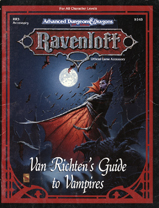 designer: Nigel D. Findley
designer: Nigel D. Findley
interior artist: Stephen Fabian
cover artist: Den Beauvai
publisher: TSR
publication date: 1991
cover: softcover
number of pages: 96
ISBN-10: 1-56076-151-2
ISBN-13: 978-1-56076-151-8
catalog number: TSR 9345 (RR3)
description: This compendium contains creatures found in the gothic Ravenloft Campaign Setting. The book is compatible with Advanced Dungeons and Dragons second edition.
Our featured entry from this bestiary concerns the necrology of vampires.
 It should should come as no surprise that a Vampire's metabolism is not like that of a mortal; in fact, strictly speaking, a vampire has no metabolism whatsoever. Although all of the biological systems present in a living mortal are also present in a vampire, most of these systems are changed in function. For example, most vampires do not need to breathe, and can function equally well in an airless crypt or in the vacuum of a void. Provided that immersion in water is not deadly to them, they can function unimpaired on the ocean floor. Vampires do retain the use of their lungs, but only for speech.
It should should come as no surprise that a Vampire's metabolism is not like that of a mortal; in fact, strictly speaking, a vampire has no metabolism whatsoever. Although all of the biological systems present in a living mortal are also present in a vampire, most of these systems are changed in function. For example, most vampires do not need to breathe, and can function equally well in an airless crypt or in the vacuum of a void. Provided that immersion in water is not deadly to them, they can function unimpaired on the ocean floor. Vampires do retain the use of their lungs, but only for speech.
Because vampires have no metabolism in the normal sense, metabolic toxins and poisons-ingested, inhaled, or insinuative-have absolutely no effect on the creatures. This is not to say there are not certain substances which, when insinuated into the body of a vampire, cause it serious or even lethal damage. These substances, although they may seem to function like poisons, are more like allergens and are usually specific to individual creatures. For example, I myself - have dispatched a vampire that was sensitive to holly, and I have heard that the ash of burned
alder wood is lethal to another certain vampire.
Some examples of vampiric allergens are yew leaves, rose petals, salt, rice, silver, mistletoe, and lilies.
The digestive tract of a vampire is greatly modified from that of a living mortal. The stomach is frequently reduced in size, often to the size of a man's clenched fist, simply because no vampire needs to ingest large volumes of solid food.
There is wide variation among vampires with regard to the ability to eat solid food. Some
vampires are unable to eat normal food at all,
and any attempt to do so results in immediate
regurgitation. Others can eat solid food with no
ill effects, although they extract no
nourishment from the food, and pass the
material through their bodies over a course of
hours, as mortals do. In the middle ground,
there are some vampires that can eat solid
food, but must regurgitate it within a period
ranging from minutes to hours. This issue may
seem incidental, but it obviously has significant
effects on a vampire's behavior, should the
creature try to masquerade as a living creature.
The circulatory system of a vampire is little
changed. The heart still pumps blood
throughout the vessels of the monster's body.
There are some differences, however. Because
vampires have no need to extract oxygen from
the air, their blood absorbs nothing from the
lungs. This renders them completely immune
to noxious gases that must be breathed to be
effective. A vampire might inhale the gas-that
is, draw it into its lungs-but the toxic
chemicals in the gas would not cross from the
lungs to the blood.
The blood of a vampire is also somewhat
different from the blood of a mortal. When
viewed normally, it has the same rich, red color
as a mortal's blood. When it is viewed by
transmitted light, such as when a vial of vampire blood is held up to a light source, it has a
distinctive golden color. Blood drawn from an
undestroyed vampire can manifest a wide
variety of powers. In some cases,-the blood is
highly caustic, causing severe acid-like damage
to anyone who touches it. In other cases, the
blood bursts explosively into flame when
exposed to sunlight. In still other cases, anyone
who touches so much as one drop of the blood
with bare skin instantly falls under the mental
sway of the vampire. It is impossible to predict
beforehand what effects the blood of a
particular vampire might have, if any. There is
one common factor: at the instant a vampire is
destroyed, any samples of his blood
immediately become completely inert, and
frequently become corrupted and rancid within
seconds...
|
|
|
|
|
January 20, 2018
Van Richten's Guide to Ghosts
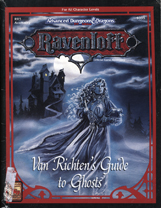 designer: William W. Connors
designer: William W. Connors
interior artists: Robert Klasnich & Stephen Fabian
cover artist: Robin Wood
publisher: TSR
publication date: 1992
cover: softcover
number of pages: 96
ISBN-10: 1-56076-351-5
ISBN-13: 978-1-56076-351-2
catalog number: TSR 9355 (RR5)
description: This compendium contains creatures found in the gothic Ravenloft Campaign Setting. The book is compatible with Advanced Dungeons and Dragons second edition.
Our featured entry from this bestiary concerns the incorporeality of ghosts.
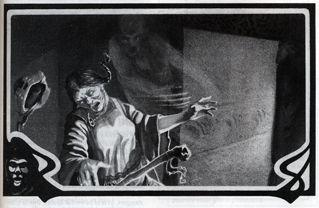 This [incorporeality] is the stereotypical state of a ghost. Having no physical existence, it moves about unfettered by physical objects such as walls or chains. Such creatures cannot be grappled, for no man can secure a hold on them. Indeed, they are immune to all manner of physical harm--swords and daggers do not bite them, and arrows and quarrels pass right through them. However, magical weapons of lesser or greater enchantment seem able to injure ghosts of this type, as do occasional arms of unique manufacture such as a silver sword.
This [incorporeality] is the stereotypical state of a ghost. Having no physical existence, it moves about unfettered by physical objects such as walls or chains. Such creatures cannot be grappled, for no man can secure a hold on them. Indeed, they are immune to all manner of physical harm--swords and daggers do not bite them, and arrows and quarrels pass right through them. However, magical weapons of lesser or greater enchantment seem able to injure ghosts of this type, as do occasional arms of unique manufacture such as a silver sword.
Such manifestations can obviously pass right through living beings. In most cases, there is no ill effect from such an encounter--although a sense of coldness or apprehension is not uncommon. In rare cases, however, a wholly incorporeal essence may have a profound effect upon an individual as it passes through.
I have myself been a victim of such an attack. As a younger man, I was confident that no incorporeal creature could directly affect me. The reader can imagine my surprise when one of these ethereal beings turned upon me and flashed through my body. The instant it penetrated me I was overcome with a feeling of the deepest horror. All my careful plans, I knew, could not prevail against this fiend. I was as nothing. In stark terror, I turned and fled.
It was more than an hour later before I came to my senses. I had been a puppet under the mastery of some fearsome creature and it had engineered my fear. I can only be thankful that the effect of the ghost's passage was not more dreadful--for I have seen the corpses of those less fortunate than I.
|
|
|
|
|
January 27, 2018
Van Richten's Guide to the Lich
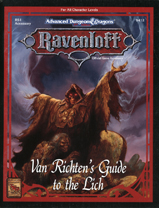 designer: Eric W. Haddock
designer: Eric W. Haddock
interior artist: Stephen Fabian
cover artist: Jeff Easley
publisher: TSR
publication date: 1993
cover: softcover
number of pages: 96
ISBN-10: 1-56076-572-0
ISBN-13: 978-1-56076-572-1
catalog number: TSR 9412 (RS1)
description: This compendium contains creatures found in the gothic Ravenloft Campaign Setting. The book is compatible with Advanced Dungeons and Dragons second edition.
Our featured entry from this bestiary concerns the phylactery of liches.
 Once the spellcasting considerations are satisfied, the wizard proceeds to the next, equally important step: the making of a phylactery, a vessel that will house his spirit.
Once the spellcasting considerations are satisfied, the wizard proceeds to the next, equally important step: the making of a phylactery, a vessel that will house his spirit.
The phylactery usually is a small boxlike amulet made of common materials, highly crafted. Lead or any other black or dark-gray colored material is frequently used. Inspection of the amulet may reveal various arcane symbols carved into the interior walls of the box, and those grooves are filled with silver as pure as the mage can find. These amulets are never made of wood, and rarely of steel. Brightly colored metals, such as gold, are infrequently used. (Mirinalithiar's account is extremely unclear, but it may not be the color which is the problem. The relative softness of the material and its subsequent likelihood of being injured may create this restriction.)
Because the mage understandably has no desire for anyone to know what ritual he is undertaking-particularly what the arcane symbols and etchings truly look like-the mage may study and learn how to handle molten metals, and he may well acquire other crafting skills necessary to design and construct the phylactery.
|
|
|
|
|
February 3, 2018
Van Richten's Guide to Werebeasts
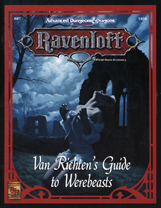 designer: Nigel Findley
designer: Nigel Findley
interior artist: Stephen Fabian
cover artist: Robh Ruppel
publisher: TSR
publication date: 1993
cover: softcover
number of pages: 96
ISBN-10: 1-56076-633-6
ISBN-13: 978-1-56076-633-9
catalog number: TSR 9416 (RR7)
description: This compendium contains creatures found in the gothic Ravenloft Campaign Setting. The book is compatible with Advanced Dungeons and Dragons second edition.
Our featured entry from this bestiary concerns the pathologic nature of lycanthropy.
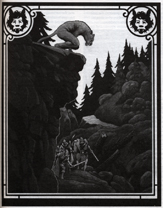 Pathologic Lycanthopy
Pathologic Lycanthopy
This is the dreaded disease described in hundreds of folktales, the cursed affliction that turns an innocent victim into a ravening beast. No race or sex is immune; it is a plight to which every man, woman, and child is susceptible.
Unlike true werebeasts, infected lycanthropes are not born with their affliction. Their condition more closely resembles a disease, in that it can be contracted and passed on. If the victim is very fortunate, it can even be cured, though not as any ordinary disease might be (see Chapter IV The Pathologic Scourge for a more in--depth discussion of cures). This form of lycanthropy can be acquired through contact with the saliva, blood, or other secretion of either a true werebeast or another infected werebeast (and perhaps even that of a maledictive one).
Simply touching a werebeast or its blood will not transmit the contagion, however. Conventional wisdom-which I have found little evidence to discount--is that the infective agent must be insinuated into the bloodstream of a victim through some wound. (A handful of legends suggest that more intimate contact may convey the affliction, but this is beyond the range of my expertise.) The chance of a victim succumbing to the scourge seems to be proportional to the severity of the wounds inflicted.
As described in a subsequent chapter, infected lycanthropes are (initially at least) unaware of their affliction. When in nonhuman aspect, they have the mentality of an animal, a ravening beast. Thus, infected lycanthropes cannot have the same kind of distinct society enjoyed by true lycanthropes.
The offspring of a father who is an infected werebeast does not automatically suffer the same affliction. Remember, there is no genetic or heritable component to this form of the scourge. However, a child born to a mother who is infected with lycanthropy will be similarly blighted. This is because there is a sharing of blood between the mother and her unborn child. The offspring does not, strictly speaking, inherit the affliction; rather, he is infected before birth. This distinction makes little difference to the innocent child, except that a cure is still possible. If the infected mother is cured of her lycanthropy before the child comes to term, the poor offspring is still susceptible to the affliction. In my estimation, such a child must undergo its own cure if it would be rid of the scourge.
|
|
|
|
|
February 10, 2018
Van Richten's Guide to the Created
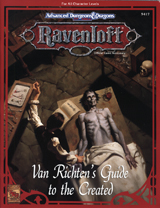 designer: Teeuwynn Woodruff
designer: Teeuwynn Woodruff
interior artist: Stephen Fabian
cover artist: Robh Ruppel
publisher: TSR
publication date: 1994
cover: softcover
number of pages: 96
ISBN-10: 1-56076-819-3
ISBN-13: 978-1-56076-819-7
catalog number: TSR 9417
description: This compendium contains creatures found in the gothic Ravenloft Campaign Setting. The book is compatible with Advanced Dungeons and Dragons second edition.
Our featured entry from this bestiary concerns the self-awareness of golems.
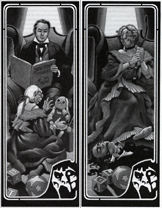 Uiews on the Self
Uiews on the Self
...As to your inquiry on the matter of the Created and their concept of the Self: The answer must surely be that they do have this conception. However, the conception of Self possessed by a golem must be a terrible one, for it seems to me the golem is similar to a feral child-raised to maturity without benefit of an appropriate figure with which to identify (i.e., a parental golem). Thus its self concept derives from its own experiences and the warping influence of its creator...
-Cassien Attenberg
Many theorists maintain that one of the basic requirements for true sentience is that the creature or being in question has an awareness of the Self. By this we mean that the being must be aware of its identity as an individual-be self aware as it were-in order to be considered truly sentient.
Through the evidence I and others have collected over the years, both first- and second-hand, it does indeed appear that the Created qualify as sentient beings. Although their consciousness is quite alien to our own, there is no question but that a golem is truly aware of its own existence as a separate being. And if a golem is indeed self-aware, then how does the creature view itself? That is the question I shall next address. However, before focusing on the Created in particular, I believe it would be helpful to briefly discuss a particular phenomenon occasionally found in human children.
Normal mortal children experience a series of stages in which they slowly develop their own sense of separate identity. If raised in a warm and loving home, a child will grow to appreciate his own worth. Such a child will, in all probability, grow up to become a productive member of his community.
However, a child who is raised in an abusive environment-and unfortunately I have seen far too many such cases-often fails to develop a sense of his own self-worth and acceptability. Such children often wind up spending their adult lives as criminals, hermits, or as other sundry social misfits.
But what of the children raised in loving homes--wanting for nothing, given education both moral and intellectual--who commit evil, despicable acts despite all the advantages a healthy environment can offer? Parents of such children often despair at their own, personal failings, wondering what they did to cause their child to behave so cruelly. When questioned, it often comes to light that the child began to behave in a selfish, cruel manner at a very early age. Such children are often labeled "bad seeds." It is perhaps an unfortunate label, and only applies to the smallest fraction of children, but in such cases it appears that the child is born with the ability to form a sense of self, but without the capability to truly care about and form attachments to others.
I mention such children for one simple reason. The Created may be the ultimate "bad seeds," incapable of identifying with others and thus incapable of true morality. Initially, golems appear to be simply curious about themselves. Like small children, they experiment and revel in new-found abilities and talents.
However, as a golem grows to realize its true nature and how it came to be, the golem often begins to view itself with ever greater self-loathing. The creature realizes it can never be truly accepted by the born and can never partake of the cycle of life (for, as I have mentioned, golems are infertile). It grows to understand how horrifying others find it, and how mortals look upon its cobbled-together body with revulsion and disgust.
Many factors in combination, certainly not limited to the ideation above, cause the golem's opinion of itself to shift. Where it initially viewed itself with mere curiosity, the golem becomes a creature filled with self-loathing. Perhaps this seeming incapacity for self-acceptance and love is at the base of the golem's evil. Perhaps when a spirit is forced into the waiting vessel--the golem body--any ability to truly love and care is lost in the process. Whatever the ultimate reasons, suffice it to say that the golem views itself with hatred.
|
|
|
|
|
February 17, 2018
Van Richten's Guide to the Ancient Dead
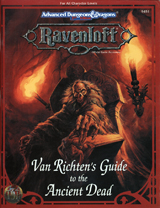 designer: Skip Williams
designer: Skip Williams
interior artists: Stephen Fabian & Paul Jaquays
cover artist: Jeff Easley
publisher: TSR
publication date: 1994
cover: softcover
number of pages: 96
ISBN-10: 1-56076-873-8
ISBN-13: 978-1-56076-873-9
catalog number: TSR 9451
description: This compendium contains creatures found in the gothic Ravenloft Campaign Setting. The book is compatible with Advanced Dungeons and Dragons second edition.
Our featured entry from this bestiary concerns the mummies of the third rank.
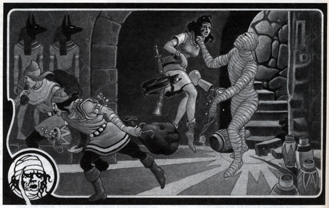 Ancient dead of the third rank are powerful enough to pose a threat to even the best-equipped adventurers. Unless one is fortunate enough to discover a weakness quickly, destroying these creatures requires great force or meticulous detective work-or both. It is at this rank that the ancient dead first exhibit salient abilities, such as spellcasting and the creation of other undead. Some third-rank mummies are indeed vulnerable to physical destruction, but it is unwise to depend on such a weakness, as some ancient dead exhibit superior rejuvenation powers at this level.
Ancient dead of the third rank are powerful enough to pose a threat to even the best-equipped adventurers. Unless one is fortunate enough to discover a weakness quickly, destroying these creatures requires great force or meticulous detective work-or both. It is at this rank that the ancient dead first exhibit salient abilities, such as spellcasting and the creation of other undead. Some third-rank mummies are indeed vulnerable to physical destruction, but it is unwise to depend on such a weakness, as some ancient dead exhibit superior rejuvenation powers at this level.
My own experience leads me to believe that third-rank mummies make up the vast majority of ancient dead. One can expect to encounter weaker mummies only when unusual circumstances prevail, and even then the lesser creatures are often tools of more powerful ones.
Mummies of the third rank do not normally rise spontaneously, though I have no evidence to suggest that they cannot do so. More typically, these types of mummies are created as the result of a powerful ritual or by the hand of a more powerful ancient dead creature.
I place the mummy found in desert tombs in this rank. Many of these creatures are vulnerable to mundane fire, but they have a potent array of powers, including paralyzing fear, a virulent form of mummy rot, and immunity to non-magical weapons. The so-called "greater" mummies (such as the ancient dead priests of Har'Akir) are also third-rank; although they are formidable, they usually-cease to be a threat once defeated in combat.
|
|
|
|
|
February 24, 2018
Van Richten's Guide to Fiends
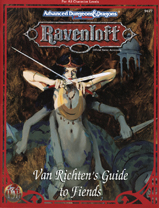 designer: Teeuwynn Woodruff
designer: Teeuwynn Woodruff
interior artist: Stephen Fabian
cover artist: Scott Burdick
publisher: TSR
publication date: 1995
cover: softcover
number of pages: 96
ISBN-10: 0-7869-0122-5
ISBN-13: 978-0-7869-0122-7
catalog number: TSR 9477
description: This compendium contains creatures found in the gothic Ravenloft Campaign Setting. The book is compatible with Advanced Dungeons and Dragons second edition.
Our featured entry from this bestiary concerns the transposition of fiends into human hosts.
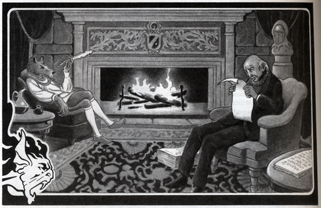 It is a universal truth that in order to thrive, evil must first be granted the opportunity to insinuate itself into a community, or into the hearts of men.
It is a universal truth that in order to thrive, evil must first be granted the opportunity to insinuate itself into a community, or into the hearts of men.
The process I term transposition is no doubt the most intimate way to invite a grand mal into
our land. Through this process, a single individual can, in one fell swoop, both destroy himself and provide a fiend with the proverbial invitation to enter the Land of the Mists.
Many believe that the stories of good and evil that priests use to instruct their flocks are parables, mere reflections of philosophic truths but not based in fact. This is not so. Whenever an individual commits a vile or vicious act, he indeed eases the way for more such acts.
Evil seeks to seduce those who open their hearts and minds to its call. Fiends, then, being creatures of absolute evil, seek out those souls that offer fertile ground for their perversions.
It seems that fiends can establish a tentative psychic connection with humans tainted by evil. If the object of the fiend's interest responds by continuing along his foul course, the connection between the two--mortal and fiend--increases in strength and becomes a physical link.
As this connection is reinforced, the fiend insinuates itself into the body and mind of its chosen victim. The culmination of the process appears to result in the transposition of the two beings; the fiend enters our land, while the host takes its place, frail flesh and all, on the fiend's home plane.
I have thus far located at least two distinct sources documenting the process of transposition. The first of these comes from the second book of the The Madrigorian, supposedly penned by the original Madrigore's daughter. However, for the sake of clarity, I will refer to the actual author, Drigor, the fiend whom I have learned is reponsible for the sixteen volume opus. The various Madrigore "authors" are mere mouthpieces for the fiend's discourses. (The ability of fieds to control the minds of mortals will be addressed in Chapter Four.)
During the course of a long treatise on the nature of reality and humanity's place in the universe, Drigor writes:
...for it is the ultimate calling of we mortals to prepare our bodies and spirits through the most debased acts. Only by acting out the secret desires that lurk in the darkest corners of our minds can we rid ourselves of the evil festering within us. Otherwise, we will forever be unclean, full of impure thoughts and desires. But if we lance the festering boils our consciences create, we might be blessed with the attention of one of the wandering Great Ones. And if we are truly vigorous and do not shirk acting out our innermost evil, then might such a Great One design to reward us by translating his body with our own. The pain of such a transportation will be glorious in its horror, but only through pain can we be cleansed. Then will we receive the highest of honors as the Great One will take our place upon this tainted land so that we might enjoy our just rewards...
--The Madrigorian, Book III, Chapter VII.
|
|
|
|
|
March 3, 2018
Van Richten's Guide to the Vistani
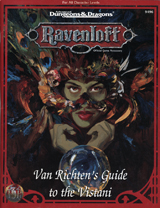 designer: David Wise
designer: David Wise
interior artist: Stephan Fabian
cover artist: Scott Burdick
publisher: TSR
publication date: 1995
cover: softcover
number of pages: 96
ISBN-10: 0-7869-0155-1
ISBN-13: 978-0-7869-0155-5
catalog number: TSR 9496
description: This compendium contains creatures found in the gothic Ravenloft Campaign Setting. The book is compatible with Advanced Dungeons and Dragons second edition.
Our featured entry from this bestiary concerns the Vistani curse known as the Poisonous Carrot.
 The Poisonous Carrot
The Poisonous Carrot
What is more cruel than to want something with all one's heart, to see that something right before one's eyes, but to know that the mere touch of it is death? When a Vistana feels especially cheated and wants to repay his pain in Vistani-kind, he lays a curse that implants desire in the heart of his enemy, but also the knowledge that to have the desired object is to summon torment or worse. The point of this curse is to make the recipient experience the Vistana's sense of loss, keenly and perpetually. If the Vistana knows of something already dear to the victim, that object often becomes the focus of the curse, doubling the retribution.
|
|
|
|
|
March 10, 2018
Van Richten's Monster Hunter's Compendium, Volume Three
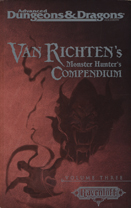 designers: David Wise, Steve Miller, Teeuwynn Woodruff
designers: David Wise, Steve Miller, Teeuwynn Woodruff
interior artist: Kevin McCann
cover artist: uncredited
publisher: Wizards of the Coast
publication date: 2000
cover: softcover
number of pages: 288
ISBN-10: 0-7869-1613-3
ISBN-13: 978-0-7869-1613-9
catalog number: TSR 11613
description: The eight Van Richten's Guides described above were collected in three volumes. Van Richten's Monster Hunter's Compendium, Volume One (1998) collected the guides to Vampires, Werebeasts and the Created. Van Richten's Monster Hunter's Compendium, Volume Two (1999) collected the guides to Ghosts, Liches and the Ancient Dead. This third volume collected the guides to fiends and the Vistani and added a third previously unpublished guide to Witches. The book contains creatures found in the gothic Ravenloft Campaign Setting. The book is compatible with Advanced Dungeons and Dragons second edition.
Our featured entry from this bestiary concerns the origin of hags.
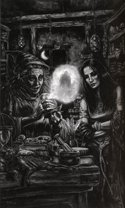 Long ago, there lived a woman whose name was Lurren. Her entire life was devoted to her husband and her children. She raised her three sons and worked the family farm, even as her husband spent his days at the local tavern, getting intoxicated with his crude friends.
Long ago, there lived a woman whose name was Lurren. Her entire life was devoted to her husband and her children. She raised her three sons and worked the family farm, even as her husband spent his days at the local tavern, getting intoxicated with his crude friends.
One day, her husband returned from town with a young woman of beauty so radiant it made Lurren's heart ache to look on her. Lurren had been beautiful once, but the hard life she had led for her husband robbed her of that beauty.
She was all too aware of this, as was her husband. "Begone, you hideous crone," he told her. "I have a new wife, a young wife. You I cast out, for you have become too old and too ugly."
Lurren begged her husband to reconsider. When he would not, she turned to her three sons and begged them to help her. They refused.
"You have grown old and ugly, Mother," they said. "Father's new wife will serve us as well as you have--even
better, in fact, because she is pleasing to the eye while you are not."
And so Lurren was driven from her home. She wandered through the dark and wild forests until her strength gave out. As she lay in a forest grove, she cried out to the heavens for the power to avenge herself against those who had used her and thrown her away for something as superficial as physical appearance. She prayed for the strength to avenge not only herself but every other woman who had ever been so slighted.
Lurren's cries were heard, and the goddess Hala responded to her pain. As Hala is wont to do, she eased Lurren's pain and gave her the means to avenge herself, blessing her with all the abilities that hags display today.
With her newfound power, Lurren enslaved the evil creatures of the forest, forcing them to serve her as she had served her ungrateful family. Then she set about exacting her revenge.
Lurren returned to her home and masked her withered visage in an illusion so beautiful that she caused her husband and sons to drive out the girl who had become his new wife. Lurren secretly captured the girl and held her captive in the nearby forest. She then slew her husband and devoured him.
Lurren's oldest son, a mighty warrior, thought that his father had abandoned them, and so he took Lurren to be his wife, seduced by her great beauty. As they shared their bed on their wedding night, she revealed her true form and slew and devoured him. She had become pregnant with her son's child, but used magical powers granted to her by Hala to transfer the child to the girl she held prisoner in the woods. That girl then gave birth to the first annis, the offspring of Lurren and her first son.
The second son, a skilled farmer and woodsman, believed that his older brother had likewise run off. After waiting a year--supposedly to let Lurren mourn--he wed her, seduced by her great beauty. As they shared their bed on their wedding night, she revealed her true form and slew and devoured him. She had become pregnant with her son's child, but used magical powers granted to her by Hala to transfer the child to the girl she held prisoner in the woods. That girl then gave birth to the first greenhag, the offspring of Lurren and her second son.
The third son, a consummate fisherman, would have grown suspicious, but Lurren was smarter than he. She cloaked herself in yet another alluring female form and tricked her youngest son into believing his brother and his wife had both run off. She spent a year using her illusionary beauty to seduce him into performing acts of unspeakable evil, and when he was no better than the beasts she had enslaved in the forest, she shared his bed, revealed her true form, and devoured him. She had become pregnant with her son's child, but used magical powers granted to her by Hala to transfer the child to the girl she held prisoner in the woods. That girl then gave birth to the first sea hag, the offspring of Lurren and her third son.
With her revenge complete, Lurren left the forest in the company of her three daughters, intending to bring doom to all men who let greed and lust guide their lives, and all who could be deceived by beauty that is only skin deep. Lurren left the young woman who had first stolen her husband with the evil forest creatures, letting them do with her as they wished.
|
|
|
|
|
March 17, 2018
Ravenloft Denizens of Darkness
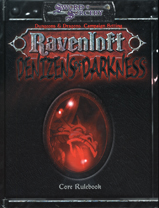 authors: Beth Bostic et al.
authors: Beth Bostic et al.
interior artist: Bob Giadrosich et al.
cover artist: Ron Thompson
publisher: White Wolf/Sword & Sorcery
publication date: 2002
cover: hardcover
number of pages: 184
ISBN-10: 1-58846-077-0
ISBN-13: 978-1-58846-077-6
catalog number: WW 15002
description: This book contains creatures found in the gothic Ravenloft Campaign Setting. The book is compatible with Advanced Dungeons and Dragons third edition.
Our featured entry from this bestiary is the valpurleiche, or the hanged man.
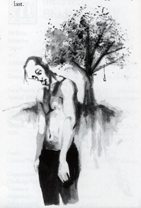 The Vistani know that on a tarokka card, the gallows can be a symbol of beginning, rather than death. The valpurleiche (wol-pur-lik) is a creature that symbolizes that the galIows are often only a doorway to a very dark beeinning. The valpurleiche, or hanged man, is the tortured form of a hanged humanoid filled with a tremendous amount of spite and hate during his execution. Some valpurleiches are created from the souls of those who were wrongly executed. Others are simply enraged criminals who want revenge despite their just sentence.
The Vistani know that on a tarokka card, the gallows can be a symbol of beginning, rather than death. The valpurleiche (wol-pur-lik) is a creature that symbolizes that the galIows are often only a doorway to a very dark beeinning. The valpurleiche, or hanged man, is the tortured form of a hanged humanoid filled with a tremendous amount of spite and hate during his execution. Some valpurleiches are created from the souls of those who were wrongly executed. Others are simply enraged criminals who want revenge despite their just sentence.
Most valpurleiches are human, though they may rise from the bodies of any humanoid. All of them bear the grisly markings of a death by hanging. Their necks are broken, so their heads loll loosely from side to side. Some have eyeballs that bulge from their sockets, and others have swollen tongues jutting from their lips.
Valpurleiches understand any languages they knew in life, but never speak except to whisper the crimes for which they were executed.
Combat:
Regardless of their alignment in life, valpurleiches are twisted to evil by their burning desire for vengeance. They seek the destruction of those who saw them hanged, and if innocent, exoneration for their crimes. A valpurleiche methodically hunts down each person it blames for its demise, but will turn on anyone who stands in its way.
The valpurleiche's preferred form of attack comes in the form of a strangle hold. They try to grapple their victims, then constrict them to death. They frequently animate ropes to create nooses to choke their foes.
|
|
|
|
|
March 24, 2018
Ravenloft Denizens of Dread
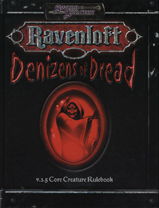 authors: Beth Bostic et al.
authors: Beth Bostic et al.
interior artist: Claudio Pozas et al.
cover artist: Ron Thompson
publisher: White Wolf/Sword & Sorcery
publication date: 2004
cover: hardcover
number of pages: 240
ISBN-10: 1-58846-951-4
ISBN-13: 978-1-58846-951-9
catalog number: WW 15006
description: This book contains creatures found in the gothic Ravenloft Campaign Setting. It is a revised and expanded version of Ravenloft Denizens of Darkness. The book is compatible with Advanced Dungeons and Dragons 3.5th edition.
Our featured entry from this bestiary is the furies.
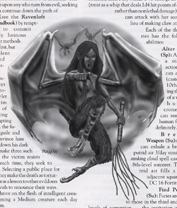 The dark swirling cloud dips lower and lower until it touches the earth. Three elderly women step from it, the years etched on their faces and hanging heavy on their stooped old bodies. They pause for a moment as if sniffing the wind before proceeding down the path.
The dark swirling cloud dips lower and lower until it touches the earth. Three elderly women step from it, the years etched on their faces and hanging heavy on their stooped old bodies. They pause for a moment as if sniffing the wind before proceeding down the path.
The Furies are three malicious sisters--Alecto, Tisiphone and Megarea--who exist to prevent the redemption of Ravenloft's evil denizens. The trio descends upon any who turn from evil, seeking to make him continue down the path of depravity (see the Ravenloft Player's Handbook) by tempting him to commit increasingly heinous crimes. Their methods are subtle at first,but grow violent when faced with resistance.
The Furies always appear together. They let their victim hear tales of their scrying abilities, tempting him to learn the future. Using guile and wit they convince him to continue down his dark path. They make three such attempts. If the victim resists temptation each time, they seek to destroy him. Selecting a public place for his demise, they make the death as torturous as possible as a lesson to other evildoers who might wish to renounce their ways. The Furies thrive on the flesh of intelligent creatures, consuming a Medium creature each day between them.
|
|
|
|
|
March 31, 2018
Van Richten's Guide to the Walking Dead
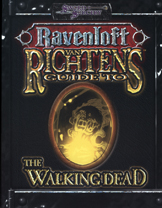 authors: Rucht Lilavivat & Ryan Naylor
authors: Rucht Lilavivat & Ryan Naylor
interior artists: Jamie Powers, Jason Walker & Talon Dunning
cover artist: Ron Thompson
publisher: White Wolf/Sword & Sorcery
publication date: 2003
cover: softcover
number of pages: 120
ISBN-10: 1-58846-085-1
ISBN-13: 978-1-58846-085-1
catalog number: WW 15011
description: This book contains creatures found in the gothic Ravenloft Campaign Setting. The book is compatible with Advanced Dungeons and Dragons third edition.
Our featured entry from this bestiary is the porcelain lady.
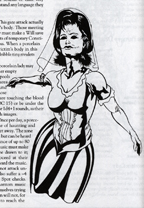 In the plantations of Souragne, the people say that a powerful baroness bathed in the blood of virgins to keep herself youthful. When her vile practices were finally discovered, she was walled up inside her own house, alive. Yet the baroness lived on, escaping her maddening prison and spreading terror even after her death.
In the plantations of Souragne, the people say that a powerful baroness bathed in the blood of virgins to keep herself youthful. When her vile practices were finally discovered, she was walled up inside her own house, alive. Yet the baroness lived on, escaping her maddening prison and spreading terror even after her death.
A porcelain lady (also called an alabaster bride) is a form of hungry undead. It is spawned From women who bathe in and drink the blood of others of their own race. This vile act serves to freeze a porcelain lady's skin for all time, making it seem as hard as alabaster. As undead, porcelain ladies seek only to fill their burning thirst for blood.
Porcelain ladies appear to be tall women who have shining porcelain instead of skin. Their skin is broken at their joints so that they seem to be life-sized puppets. The face of a porcelain lady is chilling to behold. It is a blank death mask, an unmoving visage that stares out at the world with a set of black, empty eye sockets. Porcelain ladies always wear elaborate clothes such as bridal gowns in a
futile attempt to hold onto their vanity.
Porcelain ladies cannot speak; they can only murmur incomprehensible sounds or emit tiny whimpers. They can understand any language they spoke In life.
Tears of Blood (Sp): A porcelain lady may cry streams of blood from her empty eye sockets. This blood pools out from her in a circular at the rate of 10 feet per round to a maximum of 30 feet. Those in the area of effect who are touching the blood must make a Will save (DC 15) or be under the effects of a confusion spell for 1d4+1 rounds, as their minds fill with nightmarish images.
Phantom Music (Sp): Once per day, a porcelain lady can create a zone of haunting and spectral music up to 120 feet away. The zone itself is a single 5-foot space, but can be heard in all directions for a distance of up to 80 feet. Those who hear the music must make a Will save (DC 15) or be drawn to it...They are passive and will not attack unless attacked first.
Some porcelain ladies toy with those whom they lure, dancing with them in their alabaster arms before draining their blood from their body.
|
|
|
|
|
April 7, 2018
Van Richten's Guide to the Shadow Fey
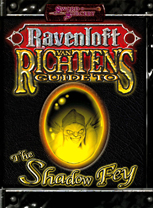 authors: Brett King, Rucht Lilavivat, Tadd McDivitt & Penny Williams
authors: Brett King, Rucht Lilavivat, Tadd McDivitt & Penny Williams
interior artists: Claudio Pozas et al.
cover artist: Ron Thompson
publisher: White Wolf/Sword & Sorcery
publication date: 2004
cover: softcover
number of pages: 128
ISBN-10: 1-58846-088-6
ISBN-13: 978-1-58846-088-2
catalog number: WW 15011
description: This book contains creatures found in the gothic Ravenloft Campaign Setting. The book is compatible with Advanced Dungeons and Dragons 3.5th edition.
Our featured entry from this bestiary is the portune.
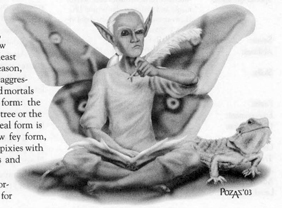 A tiny humanoid creature with black skin, a shock of white hair and big dark eyes hovers in the air, kept aloft by a delicate pair of moth-like wings.
A tiny humanoid creature with black skin, a shock of white hair and big dark eyes hovers in the air, kept aloft by a delicate pair of moth-like wings.
Portune are the most genial and shy of the Arak breeds and the least able to defend themselves. Thus,
they tend to be the most careful, quiet and soft-spoken of the shadow fey. Of all the Arak, a portune is the least likely to attack someone without reason, possessing neither the ability nor the aggressiveness to attack effectively. Around mortals they are almost always in reptile form: the snake in the grass, the lizard on the tree or the turtle in the marsh. If a portune's real form is exposed, it tries to flee. In shadow fey form, portune appear to be black-skinned pixies with white hair, overly large black eyes and white moth-like wings.
Created as a race of clerks and information keepers, the portune make up for in analytical thought an creativity what they lack in size and temperament. Hodge-podgers are by far the wisest and most knowledgeable of the arak. Their erudition serves the Arak well, so all the shadow fey breeds take care of their cousins. Not even the sadistic powrie abuse their portune brethren.
Opening a dialogue with a portune is not impossible, but it is tricky. First, the mortal wishing to communicate with the portune must recognize it. If a person calls out to a portune in reptile form, addressing it as an arak, the creature might be curious enough: to remain and question the one addressing it. Hodge-podgers don't stay to speak unless they feel completely safe. They have such soft voices that in order to hear them well, they must perch on the shoulder of the person with whom they are speaking. Portune enjoy poetry and wordplay. A diplomat shee will commonly have a portune on her shoulder, bound to her in the same way powries are sometimes bound to sith.
Permanent Wound (Su): When a hodge-podger succeeds in biting an opponent, the victim must make a DC 18 Fortitude save or suffer a wound that never heals. The target permanently loses hit points equal to the amount of damage from the bite. Only a limited wish or healing from the portune that bit the target will heal the wound and restore the lost hit points.
|
|
|
|
|
April 14, 2018
Van Richten's Guide to the Mists
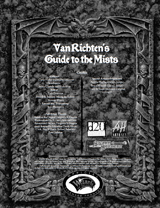 authors: Carla Hollar & Rucht Lilavivat
authors: Carla Hollar & Rucht Lilavivat
interior artist: No interior artwork
cover artist: No cover
publisher: White Wolf/Sword & Sorcery
publication date: 2005
cover: electronic (pdf format) only
number of pages: 118
ISBN-10: none
ISBN-13: none
catalog number: none
description: This book contains creatures found in the gothic Ravenloft Campaign Setting. The book is compatible with Advanced Dungeons and Dragons 3.5th edition. No print edition of this book exists.
Our featured entry from this bestiary is the mist weird.
You see an extremely tall, beautiful creature that wears a womanly shape. Its transparent body is made up of rolling fog, which drifts in hypnotic circles over and over. Her wide-eyed gaze is full of madness, shining forth with a terrible white light. The lower half of her body dissipates into a long flowing tendril of fog that oozes back into the mist bank from which she flows.
Elemental weirds are beings of foresight and prophecy. Adventurers and scholars who seek knowledge that can change the course of history search for these mysterious oracles.
In Ravenloft, Mist weirds are elemental oracles that serve the Mists of Ravenloft directly. They are perhaps the closest thing anyone in the Dread Realms can find to a direct line to the Mists.
To a mortal mind, a mist weird appears to be totally insane. Their service to the Mists means that they cannot conceive of things in a mortal fashion. They do not perceive time linearly, like most creatures. Every being they encounter has already come and gone in their minds. Every decision that one will make has already been made. The realm itself is being born and is dying all at the same time. They understand neither logic nor emotion. They know only one thing: the will of the Mists.
If an adventuring party discovers its lair, a mist weird is rarely surprised. Of course they discovered the lair. The Mists decreed it. If a mist weird utters some prophecy that is completely wrong, it is so because the Mists decided that the prophecy was wrong.
Seeking advice from a Mist weird is a risky proposition. Sometimes the advice is sound. Sometimes it is completely false. Nevertheless, many seek out these cryptic spirits in the hope of gaining some gem of knowledge.
Mist weirds are extremely rare in the Dread Realms. Their scarcity is increased by the fact that Darklords usually try to trap them as soon as possible. Such schemes often end in disaster. There are rumors of other Ravenloft elemental weirds such as blood weirds, grave weirds, and pyre weirds. However, these tales are largely unsubstantiated.
Alien Mind (Su): A Mist weird's mind is a strange amalgam of images, prophecy and whispers. Anyone attempting to read the mind or make telepathic contact with a Mist weird must make a DC 23 Madness save or contract a moderate madness.
|
|
|
|
|
April 21, 2018
Cerulean Seas: Beasts of the Boundless Blue
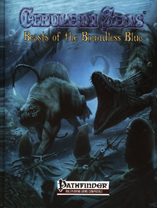 authors: Sam G. Hing, Emily Kubisz, Jeffrey Turner & Matthew Cicci
authors: Sam G. Hing, Emily Kubisz, Jeffrey Turner & Matthew Cicci
lead designer: Emily Kubisz
interior artists: Tim Adams et al.
cover artist: Forest Imel
publisher: Alluria Publishing
publication date: 2013
format: hardcover
number of pages: 292
ISBN-10: N.A.
ISBN-13: 2-370005-066096
catalog number: ALP-CS05
description: This product contains over 250 aquatic monsters, more than thirty of which also have statistics for use as playable races in the Cerulean Seas Campaign Setting. The book is compatible with the Pathfinder Role-Playing Game.
Our featured entry from this bestiary is the squid imp.
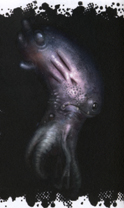 This tiny creature looks like a squid with a roughly humanoid face. Miniature arms hang at its side. Its eyes light up with delight when it sees you.
This tiny creature looks like a squid with a roughly humanoid face. Miniature arms hang at its side. Its eyes light up with delight when it sees you.
Squid imps should, by rights, be the bottom of the food chain. Their fecund breeding habits, combined with their exceedingly bitter taste allow them to be all too common in the deeper waters of the sea. They swarm over creatures that they find interesting, studying them and attempting to emulate their actions to the best of their rather limited ability.
They may be found in large numbers around both traveling humanoids, and massive predators.
Squid imps possess little combat ability, typically jetting out of harm's way, only to return within minutes. They can make small wounds with their tentacles, injecting a weak poison they use to capture small fish as prey. In general, they avoid combat with larger foes.
Squid imps seem to have a strange fascination with traveling humanoids. They will follow them endlessly, seemingly immune to all attempts to shoo them away, often singing their praises rather poorly. Most simply observe battles their hosts may engage in, but some few make an attempt to assist their heroes, generally getting under foot in the process. A very rare few squid imps are born with human level intelligence, making sages wonder if the squid imps are a devolved race, or an evolving one. The zefs have no recollection of an advanced squid imp race, but have considered them a hosts several times in the ancient past. The notion, however, was always rejected with much ridicule.
|
|
|
|
|
April 28, 2018
Free Port Bestiary
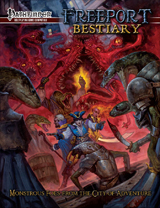 design & writing: Sam Hing, Robert H. Hudson, Jr., Alexander Marlowe, Sean O'Connor, Owen K.C. Stephens, and Mike Welham
design & writing: Sam Hing, Robert H. Hudson, Jr., Alexander Marlowe, Sean O'Connor, Owen K.C. Stephens, and Mike Welham
lead designer: Emily Kubisz
interior artists: Jesús Blones et al.
cover artist: E.M. Gist
publisher: Green Ronin Publishing
publication date: 2017
format: hardcover
number of pages: 180
ISBN-10: 1-934547-75-1
ISBN-13: 978-1-934547-75-5
catalog number: GRR1914
description: This product contains over 70 monsters, which match Freeport's mix of fantasy high-seas adventure an pulp-horror gameplay. The book is compatible with the Pathfinder Role-Playing Game.
Our featured entry from this bestiary is X'xval, Avatar of the Unspeakable One.
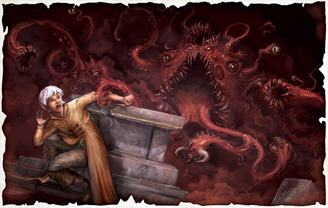 A roiling red mist the color of blood roils in the air in front of you. It shifts and changes shape constantly, and from time to time, hideous, distorted faces form and dissolve in the mist. It moves slowly but purposefully, reaching out with pseudopods and flowing through the narrowest of openings.
A roiling red mist the color of blood roils in the air in front of you. It shifts and changes shape constantly, and from time to time, hideous, distorted faces form and dissolve in the mist. It moves slowly but purposefully, reaching out with pseudopods and flowing through the narrowest of openings.
An x'sval is an amorphous, undulant fragment of an extradimensional evil extruded into this world for unnatural and vile reasons.
Tactics: An avatar of the Unspeakable One attempts to close with its opponents as quickly as possible, taking advantage of its natural confusion aura to disorient its victims while it grapples and consumes them. As most avatars encountered on the Material Plane are summoned creatures, protection from chaos or evil can be a life-saving tool when battling one of these horrors. The possession and consume abilities do not work on mindless creatures, such as constructs, oozes, and mindless undead.
Encounters: Avatars of the Unspeakable One may be summoned by cultists of the Unspeakable One using monster summoning spells. X'svals take the form of a dense red fog; they are sentient and even intelligent, but their reasoning is completely alien to mortal minds, and they can drive people to insanity just by their appearance. Avatars generally feed on whatever life-forms they find, growing stronger and spreading terror and madness until they are destroyed, though they may occasionally act in accordance with a plan ordained personally by the Unspeakable One--but such a plan would be unfathomable to most sane minds...
Ecology: As entities from outside reality, x'svals have no place in the natural order, and serve no purpose within it. They exist only to advance the Unspeakable One's will. Characters with ranks in Knowledge (planes) can learn more about x'svals with successful skill checks.
Physical Characteristics: Being in the form of a semisolid mist, an x'sval can squeeze through an opening of any size. It can also coalesce temporarily into any shape it desires, though when seen close up it is evident that the shape is made of red mist.
Society and Culture: From time to time, the Unspeakable One sends forth a tiny part of its foul, blasphemous essence into the Material Plane, either to perform some task or to answer an appeal by his cultists. X'svals are the physical manifestation of these motes of vile consciousness, and, as such are never encountered unless on a mission for the cult or cultist that summoned it, or exercising the direct will of the Unspeakable One itself.
|
|
|
|
|
May 5, 2018
Wayfinder Bestiary
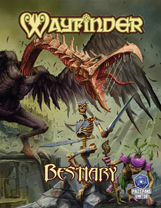 writer: Jason "Mikaze" Garrett et al.
writer: Jason "Mikaze" Garrett et al.
interior artists: Crystal Frasier et al.
cover artist: Michael Jaecks
editor-in-chief: Tim Nightengale
publisher: Paizo Fans United
publication date: 2017
format: electronic only (pdf)
number of pages: 180
ISBN-10: None
ISBN-13: None
catalog number: None
description: This product contains over 150 monsters. The book is compatible with the Pathfinder Role-Playing Game.
Our featured entry from this bestiary is the aequoreal, a jellyfish agathion.
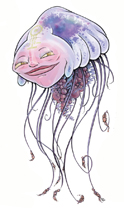 This clear and luminescent jellyfish-like creature floats gently before you. A serene, hopeful expression graces its humanoid face.
This clear and luminescent jellyfish-like creature floats gently before you. A serene, hopeful expression graces its humanoid face.
The tranquil aequoreals are common sights throughout the seas and skies of Nirvana. Their bodies resemble seemingly empty-bodied jellyfish whose "umbrella" has the shape of a humanoid head trailing thin tentacles from its "neck". This gelatinous membrane bears a humanoid face often accentuated by alien, yet beautiful, features. The umbrella and tentacles, along with the delicate neural network within, are typically translucent and glow in spots and lines with a soft blue bioluminescence, particularly the irises of the aequoreal's eyes. Aequoreals seem evenly divided among males, females, and individuals of indeterminate gender, fluctuating in accordance to their dreams.
Reflecting their once mortal nature, aequorals absorb and are nurtured by the shed mortal memories and dreams of Nirvana's petitioners, as well those shared freely by celestials and living mortals. The aequoreals, in turn, serve as a living library of these accumulated benevolent thoughts and hopes.
While mostly content to placidly enjoy, contemplate, and share their collected memories and dreams, many actively seek out those they see in dire need of hope. These aequoreals tend to latch onto sturdier and solid-bodied celestials or mortal adventurers for protection. They can be taken as familiars by 7th-level good-aligned spellcasters who utilize the Improved Familiar feat and meet the prerequisites. In this role, aequoreals often serve as muses, as well as students of the world; as they inspire with their dreams, they remain insatiably curious about what their masters might teach them. Though they loathe violence, aequoreals will act with force if gentler methods prove insufficient.
A typical aequoreal is 1 foot wide and weighs 5 pounds.
|
|
|
|
|
May 12, 2018
The Tome of Blighted Horrors
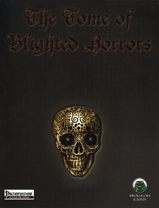 authors: John Ling, Richard Pett, Pete Pollard, Alistair Rigg, Jeff Swank & Greg A. Vaughan
authors: John Ling, Richard Pett, Pete Pollard, Alistair Rigg, Jeff Swank & Greg A. Vaughan
interior artists: Terry Pavlet, Peter Fairfax & Felipe Gaona
cover artist: Charles A. Wright
editor-in-chief: Jeff Harkness
publisher: Frog God Games
publication date: 2016
format: softcover
number of pages: 124
ISBN-10: 1-62283-364-3
ISBN-13: 978-1-62283-364-1
catalog number: none
description: This product contains over 80 creatures. The book is compatible with the Pathfinder Role-Playing Game.
Our featured entry from this bestiary is the Nightmare Choir, a Between Peacock.
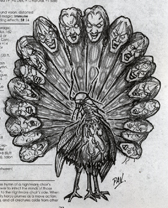 A fleshy sack, discolored with veins, sits amid and beneath a trio of gangling legs that bend in all the wrong places. A head is thrust back that looks part bird, part cockroach; its beak more akin to a stinger. Its peacock-like plume is littered with wretched-looking scraps of flesh topped by a grisly collection of severed harpy heads, the eyes of which watch you with tortured expressions.
A fleshy sack, discolored with veins, sits amid and beneath a trio of gangling legs that bend in all the wrong places. A head is thrust back that looks part bird, part cockroach; its beak more akin to a stinger. Its peacock-like plume is littered with wretched-looking scraps of flesh topped by a grisly collection of severed harpy heads, the eyes of which watch you with tortured expressions.
Captivating Hymn (Su) The hymn of a nightmare choir's harpy plumes has the power to infect the minds of those that hear it, calling them to the nightmare choir's side. When a nightmare choir raises its harpy plumes as a move action, the plumes begin singing, and all creatures aside from other nightmare choirs within a 300-foot spread must succeed on a DC 22 Will save or become captivated...A victim under the effects of the captivating hymn moves toward the nightmare choir using the most direct means available. If the path leads them into a dangerous area, such as through fire or off a cliff, that creature receives a second saving throw to end the effect before moving into peril. Captivated creatures can take no actions other than to defend themselves. A victim within 5 feet of the nightmare choir simply stands and offers no resistance to the nightmare choir's attacks. This effect continues for as long as the harpy plumes sing and for 1 round thereafter. This is a sonic mind-affecting charm effect. The save DC is Charisma-based.
Horrific Inversion (Su) As a standard action, a nightmare choir can invert itself, forming a huge maw filled with hundreds of quivering, needle-like teeth, and make a bite or tongue attack as a part of the same action. Creatures within 30 feet who witness this transformation must succeed on a DC 22 Will save or become confused (as the confusion spell) for 2d4 rounds, and gain a malady....
An inverted nightmare choir cannot use its wings or its captivating hymn but can revert to its normal form as a free action, dropping any creatures in its stomach prone in an adjacent square of its choosing.
A nightmare choir is an animalistic predator that uses the mesmerizing songs of harpies to lure prey to its side. When prey is near--and prey is anything that the nightmare choir can drain blood from--the monster suddenly inverts its body to make a surprising attack. In its usual form, it appears as a veiny sack of rubbery, feather-flecked skin, with bony, feathered wings, a swan's neck tipped with a beak-like stinger, three skinny, multi-jointed legs tipped with talons, and long, peacock-like plumes tipped with the severed heads of harpies. When the monster inverts, it suddenly bloats into a balloon of flesh that rips apart to allow a great maw of hooked teeth to burst forward, and a long, sticky tongue to shoot out to draw its prey in. The collapsed flesh sack envelops its stinger, wings, and plume, which become unusable in this alternate form.
The thirteen eye-feathers of the nightmare choir's plume are worth 100 gp each. If an eye-feather is used as an additional material component for a divination spell, the spell is affected as though by the Extend Spell metamagic feat.
|
|
|
|
|
May 19, 2018
Minecraft Mobestiary: An Illustrated Guide to the Mobs of Minecraft
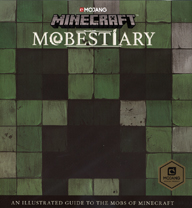 writer: Alex Wiltshire with Stephanie Milton and Marsh Davies
writer: Alex Wiltshire with Stephanie Milton and Marsh Davies
interior artist: Anton Stenvall
cover artist: Anton Stenvall
publisher: Mojang/Del Rey/Random House
publication date: 2017
format: hardcover with dustjacket
number of pages: 104
ISBN-10: 1-5247-9716-2
ISBN-13: 978-1-5247-9716-4
catalog number: none
description: This product contains description of "every creature discovered thus far" in the world of Minecraft. The book is compatible with the Minecraft video game.
Our featured entry from this bestiary is the elder guardian.
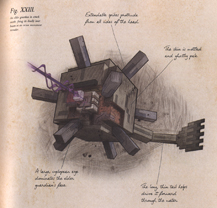 Scholars were taken aback when explorers discovered large temples deep beneath the sea and the beasts that haunt them. We know the guardians cannot have built ocean temples themselves. But they protect them, and the grotesque elder guardian is their master. A fearsome creature, the elder guardian is the reason my studies of ocean temples are incomplete.
Scholars were taken aback when explorers discovered large temples deep beneath the sea and the beasts that haunt them. We know the guardians cannot have built ocean temples themselves. But they protect them, and the grotesque elder guardian is their master. A fearsome creature, the elder guardian is the reason my studies of ocean temples are incomplete.
Elder Guardian Habitat
Three elder guardians will be found within the chambers of ocean monuments. They can easily be identified from lesser guardians since they are twice as large and deathly pale. Their skin is cracked, as if carved from some ancient rock, and their single white eye stares with a gaze that is somehow both unknowable and cruel. Thankfully, they move less energetically than guardians.
The elder guardian's connection to ocean temples means it is rare, and it seems to be becoming rarer, since it has no means of reproducing As brave adventurers slay them, elders never seem to return. (The scientific community has considered sending out parties to eradicate them once and for all, but new ocean temples are discovered daily, and the damage to our fighters would be heavy indeed.)
Battling the Horror
The elder guardian shares many of its offensive abilities with the guardian, and so for wider discussion of its basic attacks, please consult that entry. But the elder has some unique capabilities. Most evident is its toughness. Capable of taking nearly three times the damage of a guardian, the elder is a force to be reckoned with. Its own attacks--both by laser beam and body spikes--are more deadly, too.
Should an explorer manage to vanquish an elder guardian, it will drop up to two prismarine shards, a substance which when crafted together makes prismarine blocks of various types, the very substance from which ocean temples are made. It can also often drop a prismarine crystal, which can create sea lanterns...
Protector of Temples
The elder guardian is capable of detecting adventurers from great distances. Any adventurer within 50 blocks will experience a terrifying attack in which the elder guardian's ghostly form appears before them and swoops around their body. The unlucky victim is not caused any actual harm, but is cursed with an affliction that causes a strong form of mining fatigue which lasts five minutes and slows mining by many factors. (It is advised that one drinks milk to counteract this sickness.)
Most scholars believe that the elder guardian is some kind of protector of the temple: by preventing intruders from mining, they cannot damage it. We do not understand why the temple is so important to the elder guardian. If they cannot breed, they may be as old as the stones themselves.
|
|
|
|
|
May 26, 2018
Tome of Monsters
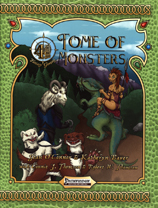 authors: Sean O'Connor & Katheryn Baker with Connie J. Thomson & Robert W. Thomson
authors: Sean O'Connor & Katheryn Baker with Connie J. Thomson & Robert W. Thomson
interior artists: Jason Ammons, Kate Ashwin, Dorian Bugg, Kristen M. Collins, Heather Crook, Juan Diego Dianderas, Talon Dunning, Marc Radle, Will Rodriguez & Hugo Solis
cover artist: Kristen M. Collins
publisher: 4 Winds Fantasy Gaming
publication date: 2011
format: softcover
number of pages: 116
ISBN-10: 1-937013-12-X
ISBN-13: 978-1-937013-12-7
catalog number: 4WF006
description: This product contains 123 entries and 29 variants. The book is compatible with the Pathfinder Roleplaying Game.
Our featured entry from this bestiary is the fallen cherub, a demon.
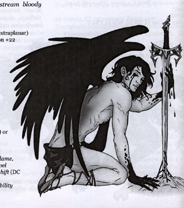 This black-winged demon still bears some of the beauty of its previous form, though its hands are stained with blood and its black eyes constantly stream bloody tears.
This black-winged demon still bears some of the beauty of its previous form, though its hands are stained with blood and its black eyes constantly stream bloody tears.
An angel falling from grace is a relatively rare occurrence, but the angels most likely to fall are the cherubim. Their long tours of duty among mortals leave them susceptible to the temptations of mortal man--especially the weaknesses of the flesh. Most cherubim are able to avoid temptation, or at least manage it. Some are even able to form and maintain healthy romantic relationships.
Unfortunately, not all cherubim remain aware enough of their actions, and can become completely obsessed with a mortal (sometimes their wards, but often not), confusing lust for love. The lust-blinded cherub begins to lose control, ignoring any protests from the object of its obsession. Some cherubim are able to come back to their senses at this point, and can atone for their sins. Those completely lost to the lust keep on their dark path, and--forgetting they're celestial beings with supernatural strength--suddenly find the object of their obsession bloody and broken in their hands, often dead. Once this happens, there is no more chance for redemption, and the cherub falls, transforming into the demonic fallen cherub.
The fallen cherub is a stalker of the worst sort. The demon picks a single target and stalks it incessantly, watching it at every move. They frequently kidnap their obsessions, keeping them isolated so their screams for help won't be heard. They are able to convince the subject at first that they're enjoying themselves, and are glad to be in the demon's care, but the demon's charm magic isn't strong enough to keep up the façade for long. A fallen cherub keeps a victim until it dies – whether due to its cumulative injuries, or directly at the demon's hands – then disposes of the body (keeping a small part as a trophy/memento) and finds a new creature to turn its obsessions toward. It is a rare creature of incredible emotional strength that can escape a fallen cherub's prison.
There is an obvious physical resemblance to its former glory, as the fallen cherub still appears to be a handsome young human, with a well-toned, muscular body. Most fallen cherubim wear black kilts or togas, and black sandals. The fallen cherub has thick black shoulder-length hair and large black wings, like those of a raven or crow. The demon's hands are permanently stained with the blood of the one it hurt when it fell from grace. It has solid black eyes, and tears of blood constantly stream from them, though a sinister smile remains on its face. The fallen cherub carries a longsword, but it does not flame like a cherub's does; instead, it appears to bleed.
|
|
|
|
|
June 2, 2018
Star Wars Galaxy Guide 12: Aliens: Enemies and Allies
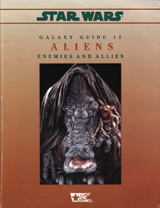 design: C. Robert Carey, Harry L. Heckel, Pablo Hidalgo, Jean Rabe & Lisa Smedman
design: C. Robert Carey, Harry L. Heckel, Pablo Hidalgo, Jean Rabe & Lisa Smedman
interior artists: Steve Bryant, Mike Vilardi, Lucasfilm Ltd.
cover art: Lucasfilm Ltd.
editor: Bill Smith
publisher: West End Games
publication date: 1995
format: softcover
number of pages: 96
ISBN-10: 0-87431-263-9
ISBN-13: 978-0-87431-263-8
catalog number: 40087
description: This product describes over thirty alien species. The book is compatible with the Star Wars Roleplaying Game.
Our featured entry from this bestiary is the chevin.
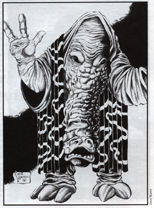 Appearance and Biology: Chevin are a migratory pachydermoid species native to the planet Vinsoth. Thick legs support massive bodies that are as big around as they are tall. Their gray hide is crisscrossed by deep wrinkles and covered by fine, but coarse, hair. Their hands, larger than their circular three-toed feet, hang at the end of massive arms that extend to their swollen kneecaps. The fingertips of the largest of Chevin sometimes brush across the ground.
Appearance and Biology: Chevin are a migratory pachydermoid species native to the planet Vinsoth. Thick legs support massive bodies that are as big around as they are tall. Their gray hide is crisscrossed by deep wrinkles and covered by fine, but coarse, hair. Their hands, larger than their circular three-toed feet, hang at the end of massive arms that extend to their swollen kneecaps. The fingertips of the largest of Chevin sometimes brush across the ground.
Their heads rest at the end of long, curved necks that angle toward the ground. The creatures have a good sense of smell, attributed to their long snouts that allow them to sniff out food without bending over. The Chevin can forage and eat while still keeping their eyes on the horizon for prey Or predators. A Chevin's eyes look like round, black marbles that seem to lack pupils. A double set of lids, one transparent, Prevent dust and wind from interfering with a Chevin's vision. Their skin is thick and padded, so their sense of touch is somewhat limited...
In spite of their size and seemingly-plodding nature, the Chevin are adroit hunters. They are masters at circling their quarry, using teamwork and weapons to defeat faster and more agile prey. Their hunting tactics allowed them to dominate the planet and enslave the humanoid Chevs, who also claim to be natives to Vinsoth. Although the Chevs are quicker than the pachydermoids, they were not able to out think the master hunters and were utterly subjugated.
Temperament: Chevin are viewed by the galaxy at large as a species of smugglers, gun runners, mercenaries, profiteers, gamblers, and blackmailers. Indeed, most of the chevin whom offworlders have come in contact with have been involved in such illegal dealings. In addition, the chevin are known slavers, ruthlessly and harshly commanding Vinsoth's humanoids. Many species avoid the pachydermoids, fearing they will also be dominated or drawn into a hopeless web of deceit. However, some avidly search out the chevin, wanting to use the pachydermoids' sources to gain vital information about various black markets.
The Chevin do not consider themselves evil or malicious. They view themselves as opportunistic realists who take what they want and who use others for profit and convenience. Their goals are simple--acquire money, power, and status. They do so through intrigue, covert manipula tion of powerful people, careful investments, and outright theft. Although they are more than capable of employing a variety of weapons, when away from vinsoth, chevin often opt to let others do any fighting for them while they stay safely in the background...
|
|
|
|
|
June 9, 2018
Earthdawn: Creatures of Barsaive
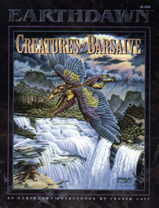 writer: Fraser Cain with Louis J. Prosperi
writer: Fraser Cain with Louis J. Prosperi
interior artists: Kent Burles, Joel Biske, Earl Geier, Jeff Laubenstein, Larry MacDougall, Jim Nelson, Mark Nelson, Mike Nielsen, David Martin, Nick Smith
cover artist: David Martin
editor-in-chief: Donna Ippolito
publisher: FASA Corporation
publication date: 1994
format: softcover
number of pages: 128
ISBN-10: 1-55560-250-9
ISBN-13: 978-1-55560-250-5
catalog number: 6105
description: This book contains fifty of the most fearsome and fascinating creatures in the province of Barsaive. The book is compatible with the Earthdawn Roleplaying Game.
Our featured entry from this bestiary is the genhis.
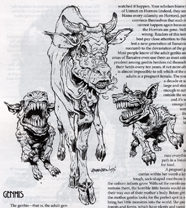 The genhis--that is, the adult genhis--is a placid, faintly foolish-looking grass eater that resembles a large cow. It even travels in herds, though only in small ones (for very good reasons). You will find it unbelievable that this gentle, slow-thinking creature long ago destroyed every village and town in the ancient troll kingdom of Ustrect--but it did. I watched it happen. Your scholars blame the razing of Ustrect on Horrors (indeed, they seem to blame every calamity on Horrors), partly to convince themselves that such destruction
cannot happen again because most of the Horrors are gone. Well, they're wrong. Readers of this tome had best pay close attention to this entry, lest a new generation of Barsaivians succumb to the devastation of the gen his.
The genhis--that is, the adult genhis--is a placid, faintly foolish-looking grass eater that resembles a large cow. It even travels in herds, though only in small ones (for very good reasons). You will find it unbelievable that this gentle, slow-thinking creature long ago destroyed every village and town in the ancient troll kingdom of Ustrect--but it did. I watched it happen. Your scholars blame the razing of Ustrect on Horrors (indeed, they seem to blame every calamity on Horrors), partly to convince themselves that such destruction
cannot happen again because most of the Horrors are gone. Well, they're wrong. Readers of this tome had best pay close attention to this entry, lest a new generation of Barsaivians succumb to the devastation of the gen his.
Most people know of the adult genhis and in some areas of Barsaive even use them as meat animals. The prudent among genhis herders rid themselves of their herds every ten years, if not more often, for it is almost impossible to tell which of the cow-like adults is a pregnant female. The young take a decade or so to grow large and strong enough to survive outside the womb, and it's when they emerge from that womb that the trouble begins. Moments after being born, young genhis begin to raze everything in their path in a frenzied search for food.
A pregnant genhis carries within her womb a large, tough, sack-shaped membrane in which the unborn infants grow, Without the membrane to restrain them, the horrible little beasts would swiftly eat their way out of their mother's body. Before giving birth,the mother genhis looks for the perfect spot in which to bring her little monsters into the world. She greatly prefers forests and farms, which have plenty and varied food for her ravenous babies-trees, birds, deer, cattle, horses, crops, people, everything. Having chosen the birthing place, the mother genhis expels the sack from her womb and runs for her life. Within a scant few minutes of landing on the ground, the baby genhis chew their way through he sack and swiftly begin eating everything within reach...
Young genhis look nothing like their parents. Instead, they resemble a moss between a bird and a lizard (remarkable, isn't it, how many Barsaivian creatures seem to look like an unfortunate hybrid of birds and lizards!), with a toothy mouth almost half the length of the entire creature. Their powerful jaws enable them to chew through anything-metal, wood, stone, and flesh. Fortunately for Barsaive, the horrid little pests frequently snack on each other soon after birth, and many a genhis brood destroys itself before doing much damage to anything else. Those that avoid becoming prey for their broodmates can destroy countless acres of land, as well as a11 inhabitants, within a few hours, though they eventually spread out to destroy more
isolated pockets of land. Why they don't eat each other in the womb, I don't know, but I surmise that magic
play some part in protecting them. As the genhis grow larger, they become less and less ravenous, after about
five years turning into placid plant eaters. Unfortunately, most of the genhis that survive are female, and though I have never seen them mate, I know that most of the females become pregnant soon after maturing...
I know of some magicians who have attempted to experiment with an intact genhis womb, and in all of
these cases the final report (usually not written by the experimenting magician) described "mixed results."
(Whatever that means. With these creatures, imagine "mixed results" are somewhat gruesome.) Those of my
readers inclined to experiment should think twice and three times before playing with a birth sack full of little
carnivores just waiting to make a meal out of every living thing in your town or village...
|
|
|
|
|
June 16, 2018
GURPS Creatures of the Night
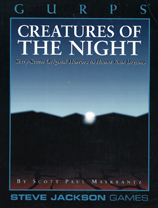 writer: Scott Paul Maykrantz
writer: Scott Paul Maykrantz
interior artist: Malcolm Hee
cover artist: Jeff Koke
editor-in-chief: Susan Pinsonneault
publisher: Steve Jackson Games
publication date: 1993
format: softcover
number of pages: 128
ISBN-10: 1-55634-273-X
ISBN-13: 978-1-55634-273-8
catalog number: SJG01995 6066
description: This product contains sixty-seven monsters. The book is compatible with the GURPS, Generic Universal Role Playing System.
Our featured entry from this bestiary is the etherwhorl.
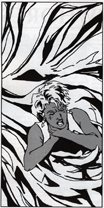 An etherwhorl is a living mist, a whirling expanse of sentient air It can adjust its temperature to alter its visibility. For example, when matching the local temperature it is invisible. By raising its temperature, it turns into a fog. Etherwhorls live in abandoned homes, graveyards, swamps and caves. They can only be detected with some sort of supernatural aid such as the Detect Life spell. They can be as small as a closet (about 75 cubic feet) or as large as a house (1,000,000 cubic feet).
An etherwhorl is a living mist, a whirling expanse of sentient air It can adjust its temperature to alter its visibility. For example, when matching the local temperature it is invisible. By raising its temperature, it turns into a fog. Etherwhorls live in abandoned homes, graveyards, swamps and caves. They can only be detected with some sort of supernatural aid such as the Detect Life spell. They can be as small as a closet (about 75 cubic feet) or as large as a house (1,000,000 cubic feet).
An etherwhorl can shift the air inside it by spinning. This alters the density of the air; if the etherwhorl moves fast enough, it can create a vacuum. Any animal or person caught inside a swirling etherwhorl may have trouble breathing. If the etherwhorl is moving slowly, it will seem like normal air flow; those inside will feel slightly short of breath. If the etherwhorl makes a formal attack, people and animals inside will feel the air move and the vacuum build around them.
Etherwhorls attack when they feel threatened, or when their homes are invaded, often accompanying the attack by a chilling howl or echoing moan...Stunned victims are disoriented, but they can notice that the air around them is moving. The etherwhorl can stop an attack at any time. Usually, the etherwhorl will carefully control their suffocation, dragging it out over a long period. It may even quit, give its victims time to regain their breath, and then attack again.
Etherwhorls cannot be harmed using conventional weapons--they are affected by psionics and spells. Spells from the Air college are particularly effective. Psionic telekinesis is useless against them, but other psychokinetic skills are useful (the pyrokinesis skill, for example, can be used to make an etherwhorl more visible).
Spells and psionic powers will also be needed to find them. The one exception is a successful Occultism (Etherwhorls) roll. (Without the specialization, roll with a penalty of -10.) They can be contacted using telepathy or the Mind-Reading spell. The communicating person will find an ethenvhorl to have a soulless, defensive demeanor--the creatures love to scare, torture and kill humans. If the person who makes contact is skillful or powerful, he may be able to control the creature.
An etherwhorl that has communicated with a human will absorb some of the human's subconscious fears. These images can be used later to scare others--if the etherwhorl is in a visible, fog-like form, it can recreate fleeting, vague replicas of these images. This usually occurs when the etherwhorl is defensive...
The Border
Each etherwhorl has a link to the border between realities. They can narrow this border by spinning (this always occurs when an etherwhorl creates a suffocating vortex). If the border narrows enough, a portal opens. It can be used to travel across the border, through the ether to another time and place.
The border between times is easier for etherwhorls to shrink than the border between space. And the past is easier to reach than the future. Generally, the larger an etherwhorl is, the greater its border-narrowing ability. All etherwhorls must make an effort (a successful IQ roll) to open a passage to a specific time or place. Otherwise, the destination is chosen by fate (the GM).
Those who pass through a portal can only return if they are at the point of arrival exactly 24 hours later. If they do not return, they remain in their new place or time. Travelers through space can usually return to their former location by conventional means. Time travelers will have much more difficulty if they fail to return...
|
|
|
|
|
June 23, 2018
Monsters of the Mind: A Psionic Bestiary for the D20 System
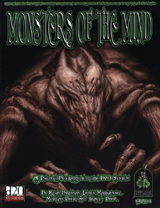 writers: Kevin Brennan, James Maliszewski, Morgan Peer & Tracey Peer
writers: Kevin Brennan, James Maliszewski, Morgan Peer & Tracey Peer
interior artists: James Ryman et al.
cover artist: Todd Lockwood
editor: Penny Williams
publisher: Green Ronin Publishing
publication date: 2003
format: softcover
number of pages: 64
ISBN-10: 0-9726756-8-X
ISBN-13: 978-0-9726756-8-0
catalog number: GRR1401
description: This product contains over fifty psionic monsters. The book is compatible with the 3.5th edition of Dungeons and Dragons.
Our featured entry from this bestiary is the tindali.
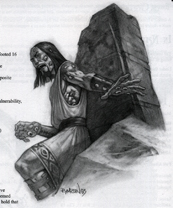 The tindali race is ancient beyond reckoning. Most tindali believe that their race is an earlier version of humanity that the gods deemed imperfect and discarded, though sages of other humanoid races hold that it is an aberrant offshoot of humankind.
The tindali race is ancient beyond reckoning. Most tindali believe that their race is an earlier version of humanity that the gods deemed imperfect and discarded, though sages of other humanoid races hold that it is an aberrant offshoot of humankind.
A tindali might be able to pass for human were it not for the one hundred eyes scattered in a seemingly random pattern over its entire body. Although these unblinking eyes make a tindali seem hideous to most humanoids, they also grant the creature truly impressive powers of perception. Certainly, nothing can hide from a tindali without great effort.
Combat: Deeply xenophobic, the tindali prefer to hide from their enemies rather than engaging them. Since they have little experience with warfare, it is not surprising that they tend to approach combat in a very simplistic manner, employing only the most rudimentary tactics. When combat is inevitable, they typically use their psionics to scan the vicinity for enemies and to soften up their foes before charging with their greatclubs. Tindali hunters may use bows as well.
Tindali Society: Tindali live beyond the fringes of civilization, usually in small, clan-based villages located in remote, out-of-the-way areas. Since a typical clan numbers less than fifty individuals, no tindali community has much impact on the local ecology.
In their remote villages, the tindali practice agriculture, hunt and fish, and develop their mental powers. In the center of each community is a stone amphitheater that serves as an atheistic school of philosophy. This structure and the philosophies taught there are central to each tindali's life. Raised from birth to believe that the gods discarded them, tindali hold that deities are inherently flawed. They espouse a particularly well-developed philosophy that embraces the development of mental abilities as life's primary goal. They spend hours of every day discussing the various problems with religions and gods and putting forth theories about how philosophy and psionics might be used to solve those problems.
A strange fate awaits any cleric, druid, monk, paladin, or other recognizably religious individual who walks into a tindali village. The tindali immediately attempt to subdue the newcomer and place him or her in stocks (Escape Artist DC 29) in the middle of a "debating circle" in the school. Here the tindali use every cogent argument they can muster to convince the prisoner that the gods are petty and vain creatures that are not deserving of worship. The prisoner receives no food for as long as he or she rejects the tindalis' position, and a particularly obdurate individual who cannot escape may well starve to death. Should the prisoner claim to have seen the light, the tindali use their psionics to verify whether the "conversion" is genuine. If the prisoner is lying, the process of convincing continues. If not, they behead the prisoner, having successfully brought him or her enlightenment.
|
|
|
|
|
June 30, 2018
Bladestorm Bestiary
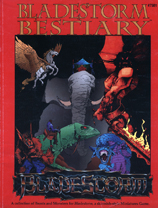 author/designer: Tim Taylor
author/designer: Tim Taylor
interior artists: Paul Jaquays et al.
cover artist: Terry K. Amthor (a collage of the art of Sandy Collora, Darrell Midgette, Paul Jaquays and David Miller)
editor: Coleman Charlton
publisher: Iron Crown Enterprises
publication date: 1991
format: softcover
number of pages: 96
ISBN-10: 1-55806-148-7
ISBN-13: 978-1-55806-148-4
catalog number: ICE 1300
description: This product contains over one hundred beasts and monsters of the Bladelands. The book is compatible with the Bladestorm miniatures system.
Our featured entry from this bestiary is the shard.
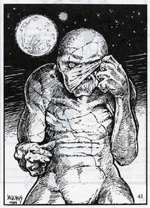 In appearance Shards resemble tall featureless men whose bodies are covered with a thick greenish hide. Nocturnal, arboreal predators, Shards normally live in groups of six nesting in the trees of rain forests. They are omnivores, but retain a fondness for fresh brains. They race about with blinding speed, leaping great distances between trees. In motion, Shards are extremely difficult to hit. When attacking, Shards must remain relatively motionless; at this time, they are most vulnerable. Their attack consists of bony discs which are flung forward with deadly accuracy. Their missiles are coated with a lethal poison composed of diluted blood. Treat this poison as the first level Essence spell Paralyze Legs, applied in addition to normal damage.
In appearance Shards resemble tall featureless men whose bodies are covered with a thick greenish hide. Nocturnal, arboreal predators, Shards normally live in groups of six nesting in the trees of rain forests. They are omnivores, but retain a fondness for fresh brains. They race about with blinding speed, leaping great distances between trees. In motion, Shards are extremely difficult to hit. When attacking, Shards must remain relatively motionless; at this time, they are most vulnerable. Their attack consists of bony discs which are flung forward with deadly accuracy. Their missiles are coated with a lethal poison composed of diluted blood. Treat this poison as the first level Essence spell Paralyze Legs, applied in addition to normal damage.
An experiment by the Soulslayers seeking the ultimate assassin, Shards escaped into the wilds of Folenn. Unable to reproduce, Shards' numbers are perforce small, but their awesome qualities ensure survival.
Shards move at such a fantastically high rate of speed that they cannot be moved as ordinary combatants. Their Movement Rate is so great that they can conceivably move to any point on the battlefield each turn. To reflect this, when a Shard moves, it is removed from the playing surface, and a new location is chosen by its player. A Shard may move and then make a missile attack during its movement-missile phase. Shards may ignore the normal restrictions for moving within 2" of a unit.
|
|
|
|
|
July 7, 2018
Star Trek Roleplaying Game: Creatures
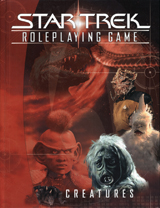 authors: Bill Maxwell, Aaron Rosenberg, Peter Schweighofer & Owen Seyler
authors: Bill Maxwell, Aaron Rosenberg, Peter Schweighofer & Owen Seyler
interior artists: Paul "Prof" Herbert & Anthony Hightower
art direction & graphic design: Jesse Cassem
publisher: Decipher
publication date: 2003
format: hardcover
number of pages: 96
ISBN-10: 1-58236-908-9
ISBN-13: 978-1-58236-908-2
catalog number: No. 103606
description: This product contains over one hundred monsters. The book is compatible with the Star Trek Roleplaying Game.
Our featured entry from this bestiary is the tribble.
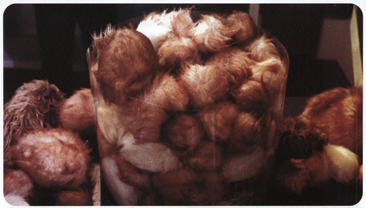 Cuddly, soft, harmless furballs in colors from calico to auburn, tribbles seem like the ultimate pet. They're clean, they freely show affection, and they eat anything. And everything. And convert this nutrition into more tribbles. And more tribbles. And more tribbles. A small ball of fluff; 5-20 cm long, massing 30-2000 g.
Cuddly, soft, harmless furballs in colors from calico to auburn, tribbles seem like the ultimate pet. They're clean, they freely show affection, and they eat anything. And everything. And convert this nutrition into more tribbles. And more tribbles. And more tribbles. A small ball of fluff; 5-20 cm long, massing 30-2000 g.
In their wild state, tribbles must have existed in an almost insupportably predator-rich environment. Slow, weaponless, and tasty, their sole defense is a kind of trilling, which creates a state of happy calm in most mammals. Only Klingons seem resistant to it; the two species react with instant mutual dislike (Willpower reaction test against TN 25 to resist recoiling). For this reason, the Klingon Defense Force wiped out the tribble homeworld during a controversial, expensive mission in the 2280s-only to see their work undone by individual traders (who had hoarded the lucrative pets) and by an unauthorized Starfleet time voyage in 2373.
|
|
|
|
|
July 14, 2018
HârnWorld Bestiary: A Compendium of Creatures
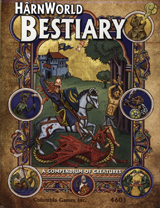 note: Each entry in the bestiary has separate attributions for author, artist and editor.
note: Each entry in the bestiary has separate attributions for author, artist and editor.
writer: Alun Rees (tawedog)
interior artists: Richard Luschek (tawedog)
cover artist: uncredited
editors: Brent Bailey & Grant Dalgliesh (tawedog)
publisher: Columbia Games Inc.
publication date: 2015
format: loose sheets of paper in folder
number of pages: 110
ISBN-10: 0-920711-69-3
ISBN-13: 978-0-920711-69-9
catalog number: 4601 (folder), 4622 (tawedog)
description: This product contains over NUMBER monsters. The book is compatible with the HârnWorld Roleplaying Game.
Our featured entry from this bestiary is the tawedog.
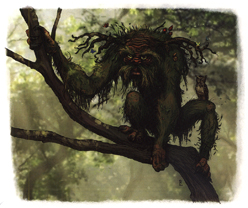 The "Old Ones of the Forest" are one of the most elusive and
mysterious of the sentient species of the Misty Isle. They once ranged
throughout primeval Peran before the coming of the Kubora and Urdu but
today are rare even among the dense forests of the northern coastal plain.
The "Old Ones of the Forest" are one of the most elusive and
mysterious of the sentient species of the Misty Isle. They once ranged
throughout primeval Peran before the coming of the Kubora and Urdu but
today are rare even among the dense forests of the northern coastal plain.
These shy creatures are taller than a man by more than half, their rangy
frame covered in stringy, ruddy brown hair tinged blue-green with moss
and often tangled with plant debris. This natural camouflage renders them
almost invisible when standing still, something they can do for hours. This
talent may explain why the tribes believe them capable of magic. Their
faces are human-like, with flatter noses and deep-set eyes well adapted to
the perpetual twilight of the deep forest. The Kuboran practice of facial
branding and mutilation, known as Arus, may be an imitation of the deep
folds of skin and creases that mark the faces of Old Ones.
The sexes appear similar except males have horns that resemble tree
roots. Young are born live after a gestation of 12 months and are largely
independent of their mothers within weeks. Old Ones are believed to be
extremely long-lived and capable of complex symbolic thought, but no
Kuboran has ever reported communication beyond awestruck one-sided grft
giving. It may be that the Tawedog worldview is so alien, and their patterns
of thought so abstract, that it is impossible for them to relate to humans.
The Old Ones are unknown in civilized lands but for a very few sages,
who assume they are a rare and exotic variety of Ivashu. The first trapper
to introduce an Old One to the Pamesani Arena would become wealthy
indeed!
WAY OF LIFE
Tawedog live solitary lives in nests built high in the
forest canopy from where, very occasionally, their low,
booming roar will echo through the forest to announce a
readiness to mate.
They are equally at home moving almost silently
through the forest undergrowth as they are swinging
from branch to branch in the canopy. This makes them
notoriously difficult to track, their unique five-toed tracks
often coming to an abrupt end as the creature pulls itself
up into a tree using its long arms and disappears. Only
the greatest tribal hunters can hope to follow an Old One
for more than half a league. A few boast they can track
the Tawedog's aerial trail from the ground.
If confronted, an Old One is likely to flee. The
Tawedog are at their most dangerous when roused to
anger. The scent of their enemy's blood triggers a berserk
rage that is only assuaged when the opponent is dead and
the normally herbivorous Tawedog has chewed the meat
from its bones. Tales tell of men decapitated with the
sweep of an Old One's clawed hand. This is the aspect
of the creature that Kuboran and Urdu mothers use to
frighten mischievous children: "take care lest you anger
the Old Ones."
LORE
Kuboran legend has often linked Crador the Blind,
one of the tribal gods, to the Old Ones of the Forest.
Crador was always indulged by his father, Kemlar the
Guide, but when the young man went so far as to
dishonor a chieftain's daughter, revenge was taken.
The youth was blinded so he might never look upon
a woman again and, mad with pain and anger, cast out
into the forest to die. There, a wandering Tawedog fed
and protected him and taught him the ways of the forest.
Today, any who harm, or permit harm to befall, these
usually gentle creatures risk Crador's anger and the bad
luck that can bring. Offerings of fruit and fermented
beverages are left at the edge of Kuboran and Urdu
villages on the night of the full moon to propitiate the Old
Ones and keep Crador's nightmares at bay...
|
|
|
|
|
July 21, 2018
Creatures of the Dreamseed
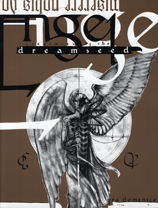 author: Oliver Graute
author: Oliver Graute
translators: Ole Johan Christiansen and Thomas Plischke
interior artists: Jean Linnhoff
cover artist: Jean Linnhoff
publisher: Feder & Schwert/Sword & Sorcery Studios/White Wolf Publishing
publication date: 2003
format: softcover
number of pages: 128
ISBN-10: 1-58846-122-X
ISBN-13: 978-1-58846-122-3
catalog number: WW17001
description: This book describes the travels and creatures encountered of Fra Domenico in the year 2654. The book is compatible with the Dreamseed Roleplaying Game.
Our featured entry from this bestiary is the scare.
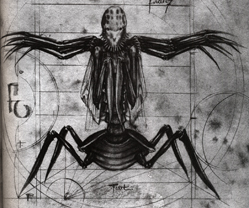 How could I have been fooled into believing that I will see a day when the Lord does not hold new challenges in store for me? Something awful had occurred at this farm, something of a natures pleasing to the Lord of Flies, something that brings havoc to peaceful lives. Something cruel and hideous. Once again, my theory concerning the Adversary's boundless, malevolent imagination was verified; to be more precise, the filtrate of human fears seems to be inexhaustible and the Tempter, as we have seen first hand, knows all too wel how to give shape to these fears.
How could I have been fooled into believing that I will see a day when the Lord does not hold new challenges in store for me? Something awful had occurred at this farm, something of a natures pleasing to the Lord of Flies, something that brings havoc to peaceful lives. Something cruel and hideous. Once again, my theory concerning the Adversary's boundless, malevolent imagination was verified; to be more precise, the filtrate of human fears seems to be inexhaustible and the Tempter, as we have seen first hand, knows all too wel how to give shape to these fears.
In the water on the edge of the rice field, we found evidence of another of the Lord of the Flies sinister schemes: the corpses of a man and a woman torn to pieces by some clawed beast and simply left where they had fallen. No animal can ever be responsible for such atrocities. Only Dreamseed creatures and a certain kind of people, those godless, deviant people, Heretics. I abandoned myself far too carelessly to my own anger at their finding, however: I did not even notice the scarecrow standing so close to the two corpses. But then its sudden wide grin alerted me, and I realized that its outstretched arms waved in a breeze that did not exist, but it was too late for me to run away.
Immediately, the Scare fell upon me, its thin limbs unraveling in order to slash at me with its great talons. Bran's courage saved my life yet again when he flung himself with all his weight against the Dreamseed creature, disappearing with it into the water covering the rice fields. As quickly as the shock of my situation allowed me to, I pulled away from the Scare to observe it locked in its fierce fight with Gran. At that moment, however, I noticed movement at the other end of the fields, and only then did I understand into what a dangerous trap we had been led...
|
|
|
|
|
July 28, 2018
The Legend of Zelda: Breath of the Wild: Complete Official Guide, Collector's Edition (2017)
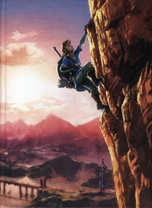 co-authors: Tony Gao & James Price
co-authors: Tony Gao & James Price
art directors: Jeanette Killmann & Martin C. Schneider (Clorienschein)
designers: Christian Runkel & Christian Schmal
editorial director: Mathieu Daujam
publisher: Louie Beatty, Vincent Pargney/Piggyback Interactive Limited
publication date: 2017
format: hardcover
number of pages: 370
ISBN-10: 1-911015-22-2
ISBN-13: 978-1-911015-22-2
description: This product contains over seventeen categories of monsters. The book is compatible with the Legend of Zelda: Breath of the Wild video game. Of relevance to this survey, the book includes a bestiary on pages 300-323.
Our featured entry from this bestiary is the guardian scout.
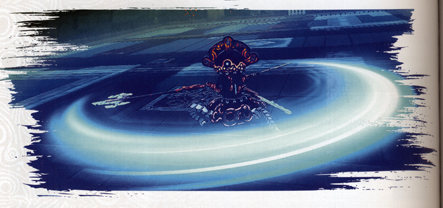
QUICK SHOTS: Guardian Scouts often unleash a quick volley of gun shots as they move toward you. These are usually of no consequence. Ignore them completely, focusing on the strategy you have chosen to eliminate your target.
STANDARD ATTACKS: The primary method of attack for Guardian Scouts is to deal melee blows with the weapon(s) they are wielding. These are all fairly predictable, and you should have no problem identifying the best perfect dodge window with a little practice. Follow up with flurry rushes and standard combos, ideally with an ancient weapon if you have one to hand.
SPINNING BLADE ATTACK: You will regularly see a Scout leap backward and focus briefly with its weapons at the ready. This will be followed seconds later by a swirling attack where the machine closes in on your position. This is very difficult to dodge, so the best course of action is to hide behind a suitable obstruction, such as a pillar. The Scout will crash into it, damaging itself in the process and suffering a short stun effect: use this
opportunity to unleash your best combos. Certain shrines do not feature natural cover points. In these instances, you must create them yourself. If there is water at your feet, summon a pillar of ice with Cryonis; if you spot blocks of metal in the ground, raise them with Magnesis...If you do not have enough time to complete these maneuvers, a shock or ice arrow can also halt their advance...
FOCUSED LASER ATTACK: Once you have depleted most of your opponent's health, it will put all of its weapons away and start charging a powerful laser beam - the exact same attack as the one employed by Guardian Vehicles. You have two options at this stage: either rush to your target and attack relentlessly until it falls (which only makes sense if you are powerful enough to deliver the coup de grace within a few seconds), or step back, draw your shield, and perfect guard the beam. If you are fighting at close quarters, don't forget that you must execute the parry command just before the beam is emitted...
ELEMENTAL STRATEGY: Another safe approach against Scouts, particularly the stronger models, is to deploy elemental weapons. Hit them with any ice-infused sword or arrow to freeze them, then switch to the most powerful item in your inventory: it will deal triple damage by shattering the ice. Switch back to your ice weapon and continue the process until your foe falls. Alternatively, you can use lightning-imbued weapons to shock a Scout for a few seconds, then unleash a combo with a stronger weapon. Shock damage is enhanced if your opponent is standing on surface water.
|
|
|
|
|
August 4, 2018
Ye Booke of Monstres, The Aniolowski Collection, Volume I
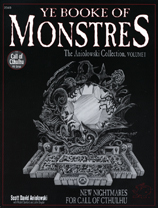 authors: Scott David Aniolowski et al.
authors: Scott David Aniolowski et al.
interior artists: Rodell Sanford, John T. Snyder & Allen Koszowski
cover artist: Charlie Krank
publisher: Chaosium Inc.
publication date: 1994
format: softcover
number of pages: 64
ISBN-10: 1-56882-019-4
ISBN-13: 978-1-56882-019-4
catalog number: 2349
description: This product contains over sixty monsters. The book is compatible with the Call of Cthulhu roleplaying game.
Our featured entry from this bestiary is Ghroth, an outer god.
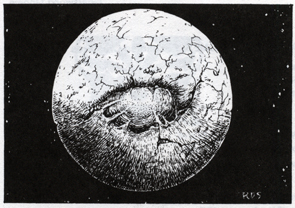 It was red as rust, featureless except for bulbous protrusions like hills...Except that of course they weren't hills if he could see them at this distance: they must be immense. It seemed to hang ponderously. communicating a thunderous sense of imminence, of power...Then it moved...The surface of a planet doesn't move...the surface of a planet doesn't crack, it doesn't roll back like that, it doesn't peel back for thousands of miles so you can see what's underneath, pale and glistening.
It was red as rust, featureless except for bulbous protrusions like hills...Except that of course they weren't hills if he could see them at this distance: they must be immense. It seemed to hang ponderously. communicating a thunderous sense of imminence, of power...Then it moved...The surface of a planet doesn't move...the surface of a planet doesn't crack, it doesn't roll back like that, it doesn't peel back for thousands of miles so you can see what's underneath, pale and glistening.
Ramsey Campell, "The Tugging"
Ghroth has a few worshipers. mostly astrologers and others interested in the stars, The Outer God is a son of "Nemesis Star": a planet-sized, star-like entity made up of gas and ash and molten iron. It appears as a vast rust-red sphere, its surface split with faults or cracks. Ghroth occasionally forms great eyes out of vast seas hidden below its crust. Its absence from the restraints of Azathoth's mindless court is due to the eternal duty it must perform. Ghroth is the herald of songs which only the pitiless stars and the dead Old Ones can hear. The stars are urged to rightness and the Old Ones awaken on the worlds; which Ghroth passes.
Ghroth is the Harbinger and the Maker of the Doom of Worlds. As the Outer God nears a world, tides change, horrific storms, earthquakes. and tidal waves are experienced, volcanos erupt, etc. The arrival of Ghroth signals catastrophe for solar systems as the Outer God begins to pull planets into new orbits and awaken dark, slumbering gods with its music of the spheres.
There is some speculation that the appearance of Ghroth was the cause of me destruction of Shaggai.
|
|
|
|
|
August 11, 2018
Ye Booke of Monstres, The Aniolowski Collection, Volume II
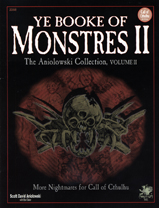 authors: Scott David Aniolowski et al.
authors: Scott David Aniolowski et al.
interior artists: Earl Geier
cover artist: Eric Vogt
publisher: Chaosium Inc.
publication date: 1996
format: softcover
number of pages: 64
ISBN-10: 1-56882-052-6
ISBN-13: 978-1-56882-052-1
catalog number: 2358
description: This product contains sixty monsters. The book is compatible with the Call of Cthulhu roleplaying game.
Our featured entry from this bestiary is Ossadagowah, son of the Great Old One, Tsathoggua.
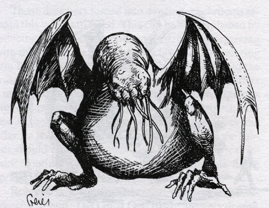 It was a grotesque monstrosity, a gross, corpulent, toadlike thing with an obscene, swollen paunch and huge, splayed, clawed feet, but without the forelimbs its toadlike shape might be expected to have. From a point along the back...sprouted crook-ribbed wings, like those of some monstrous bat... Face it had none, but from the forepart of its sloped, bulging and misshapen head slithering and snakelike tendrils
sprouted...
It was a grotesque monstrosity, a gross, corpulent, toadlike thing with an obscene, swollen paunch and huge, splayed, clawed feet, but without the forelimbs its toadlike shape might be expected to have. From a point along the back...sprouted crook-ribbed wings, like those of some monstrous bat... Face it had none, but from the forepart of its sloped, bulging and misshapen head slithering and snakelike tendrils
sprouted...
Lin Carter, 'Strange Manuscript Found in the Vermont Woods'
This entity also known as Zvilpoggua, is referred to as the "son of Tsathoggua" or "the first son of Tsathoggua" in Mythos tomes. It may be one of the horrible children of Tsathoggua grown to monstrous age and proportions. Ossadagowah is known as a devil entity to certain tribes of American Indians, particularly in the New
England area.
Ossadagowah attacks by grasping victims in its writhing, snake-like tendrils and flying off with them. The Great Old One feeds on its victims while soaring through the air, dropping their lifeless corpses to the earth once it has finished with them. The Feaster from the Stars inflicts 2d6 hit points of damage and drains 1d10 points of STR (blood) from its victims each round. Once a victim has been grasped and the entity takes to the sky there is little hope of salvation. Those victims who manage to break out of the Great Old One's grip plummet to the earth, suffering 1d6 points of damage per ten feet of their fall upon impact with the ground. Ossadagowah may carry off 41 SIZ (the average of its STR and SIZ) worth of victims at a time.
Ossadagowah may be called to earth only at certain times when the star Algol is above the horizon. If reduced to zero hit points, the Great Old One becomes a shapeless cloud and dissipates. It cannot regenerate and return until the next rising of Algol.
|
|
|
|
|
August 18, 2018
Savage Coast: Monstrous Compendium Appendix
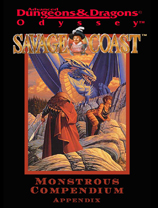 design: Loren L. Coleman, Ted James & Thomas Zuvich
design: Loren L. Coleman, Ted James & Thomas Zuvich
interior artists:Earl Geier, John T. Snyder & Christina Wald
cover artist: Larry Elmore
editing: Cindi M. Rice
publisher: TSR, Inc.
publication date: N1996
format: electronic (pdf)
number of pages: 126
ISBN-10: N.A.
ISBN-13: N.A.
catalog number: 2524
description: This product contains over 70 monsters. The book is compatible with the second edition of the Dungeons and Dragons roleplaying game.
Our featured entry from this bestiary is the wallara.
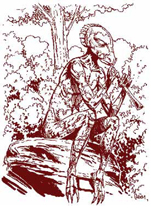 The wallaras (sometimes called chameleon men) are the oldest of the lizard kin races and are descended from dragons. Once a proud and wise race, the wallaras were reduced to their current primitive state through the action of the araneas. (See The SAVAGE COAST Campaign Book.) The wallaras inhabit the extensive grasslands on the northern shore of the Orc's Head Peninsula, far from human and demihuman civilizations, so the reclusive wallara do not have to work too hard to avoid contact with strangers.
The wallaras (sometimes called chameleon men) are the oldest of the lizard kin races and are descended from dragons. Once a proud and wise race, the wallaras were reduced to their current primitive state through the action of the araneas. (See The SAVAGE COAST Campaign Book.) The wallaras inhabit the extensive grasslands on the northern shore of the Orc's Head Peninsula, far from human and demihuman civilizations, so the reclusive wallara do not have to work too hard to avoid contact with strangers.
Wallaras stand seven feet tall, and their spindly arms and legs make them look quite thin. Some folk think that they resemble tall, slender humans. They move with a stride that other races find gangling and awkward. Wallaras have multicolored, somewhat scaly skin with stripes of various shades of red, blue, indigo, green, yellow, violet, brown, orange, black, and white. Few wallaras have every hue; most have three or four predominant colors. The colors seem to shift and swirl when they walk. Wallaras never show any sign of discoloration from the Red Curse...
Combat: Wallaras usually arm themselves with light weapons: daggers, spears with wommeras (throwing holders), or clubs called nulla-nullas. They prefer to use nonmetal weapons and equipment. They never wear armor, as it interferes with their natural abilities; whenever possible, they would rather blend into the scenery than fight openly.
Their most useful ability by far is their vanishing ability, which they use to avoid combat or surround opponents. Each round, a wallara can vanish and reappear up to 120 feet away. The ability is essentially the dimension door spell with a 120-foot range. They wield such precise control over the ability that they never reappear in midair or inside solid objects. Of course, they cannot appear in the exact spot as someone or something else, neither can they attack and use this ability in the same round...
Habitat/Society: All wallaran settlements feature a magical site called a tookoo. The tookoo of a clan is the equivalent of a temple to many other races. The tookoo of a cave-dwelling clan might be a special grotto that glistens with arcane crystals. Forest dwellers might revere an ancient tree of strong magic....
Once a year, chameleon men shed their skins, much as lizards do. They save the skin for a vital purpose: reproduction. As the race has no female gender, they reproduce by placing their old skins in their clan's tookoo. Each offering has a 5% chance of magically budding into a young wallara, which grows to maturity in just eight weeks. The new wallara then stays with the tribe for at least a year to learn a trade.
Wallaras, like their dragon ancestors, are a long-lived race. A lucky wallara can live as long as 250 years. Wallaras who are older than 200 years develop 10% magic resistance, a holdover from their dragon ancestry.
Wallara live in quiet harmony with nature. A Herathian spell reduced them to a stone-age level of development, and they are just now beginning to rediscover their past. They enjoy games of all sorts. When they war among themselves, the battle is stylized and designed to let out frustrations and grievances without causing a great deal of harm to anyone.
At some point during their lives, most wallaras experience a sort of wanderlust and leave for a period of time to explore the world. This is known as going on walkabout. Even while on walkabout, wallaras rarely leave the grasslands. A wallara on walkabout is almost always accompanied by a wallaran spirit...
|
|
|
|
|
August 25, 2018
Papertoy Monsters
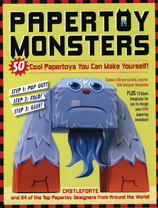 writer: Brian Castleforte
writer: Brian Castleforte
interior artists: Robert James
photography: Jen Browning and Netta Rabin
design: Netta Rabin
publisher: Workman Publishing
publication date: 2010
format: softcover
number of pages: 234
ISBN-10: 0-7611-5882-0
ISBN-13: 978-0-7611-5882-0
description: This product contains over fifty monsters. The book comes with pre-scored easy-to-fold templates to make three-dimensional paper versions of the monsters.
Our featured entry from this bestiary is Polyphemus.
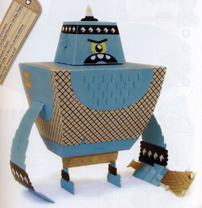 This ancient one-eyed giant originally came from Cyclopedia in the Aegean Sea. He is almost five thousand years old, and very nearsighted, which makes him clumsy, so he often bumps into things when he walks. In addition to being rather lumbering and slow, he is not very smart--he basically doesn't to anything more than moan and groan all day and night. He has a giant wooden hammer that he swings quite often, but since he can't see very well, the hammer hardly ever hits its target. Instead of munching on people, which are his favorite treat, Polyphemus has to content himself with eating jellyfish that wash up on the beach where he lives.
This ancient one-eyed giant originally came from Cyclopedia in the Aegean Sea. He is almost five thousand years old, and very nearsighted, which makes him clumsy, so he often bumps into things when he walks. In addition to being rather lumbering and slow, he is not very smart--he basically doesn't to anything more than moan and groan all day and night. He has a giant wooden hammer that he swings quite often, but since he can't see very well, the hammer hardly ever hits its target. Instead of munching on people, which are his favorite treat, Polyphemus has to content himself with eating jellyfish that wash up on the beach where he lives.
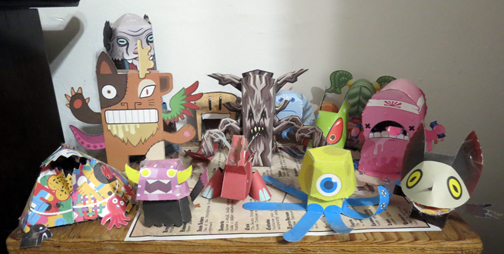
Several constructed creatures from Papertoy Monsters.
|
|
|
|
|
September 1, 2018
The Book of Beasts: Being a Translation from a Latin Bestiary of the Twelfth Century
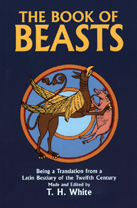 translator and editor: T. H. White.
translator and editor: T. H. White.
author: uncredited twelfth century author
interior artists: uncredited twelfth century illustrator
cover artist: uncredited
publisher: Dover Publications
Dover publication date: 1984
original translation publication date: 1954
format: softcover
number of pages: 296
ISBN-10: 0-486-24609-4
ISBN-13: 978-0-486-24609-3
description: This book is an English translation of a Latin bestiary from the twelfth century.
Our featured entry from this bestiary is the elephant.
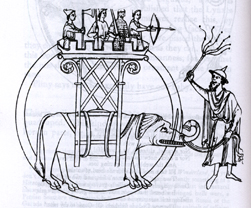 There is an animal called an ELEPHANT, which has no desire to copulate.
There is an animal called an ELEPHANT, which has no desire to copulate.
People say that it is called an Elephant by the Greeks on account of its size, for it approaches the form of a mountain: you see, a mountain is called 'eliphio' in Greek. In the Indies, however, it is known by the name of 'barrus' because of its voice--whence both the voice is called 'baritone' and the tusks are called 'ivory' (ebur). Its nose is called a proboscis (for the bushes), because it carries its leaf-food to its mouth with it, and it look ilke a snake.
Elephants protect themselves with ivory tusks. No larger animals can be found. The Persians and the Indians, collected into wooden towers on them, sometimes fight each other with javelins as if from a castle. They possess vast intelligence and memory. They march about in herds. And they copulate back-to-back.
Elephants remain pregnant for two years, nor do they have babies more than once, nor do they have several at a time, but only one. They live three hundred years. If one of them wants to have a baby, he goes eastward toward Paradise, and there is a tree there called Mandragora, and he goes with his wife. She first takes of the tree and then gives some to her spouse. When they munch it up, it seduces them, and she immediately conceives in her womb. When the proper time for being delivered arrives, she walks out into a lake, and the water comes up to the mother's udders. Meanwhile the father elephant guards her while she is in labour, because there is a certain dragon which is inimical to elephants. Moreover, if a serpent happens by, the father kills and tramples on it till dead. He is also formidable to bulls--but he is frightened of mice, for all that.
The Elephant's nature is that if he tumbles down he cannot get up again. Hence it comes that he leans against a tree when he wants to go to sleep, for he has no joints in his knees. This is the reason why a hunter partly saws through a tree, so that the elephant, when he leans against it, may fall down at the same time as the tree. As he falls, he calls out loudly; and immediately a large elephant appears, but, it is not able to lift him up. At this they both cry out, and twelve more elephants arrive upon the scene: but even they cannot lift up the one who has fallen down. Then they all shout for help, and at once there comes a very Insignificant Elephant, and he puts his mouth with the proboscis under the big one, and lifts him up. This little elephant has, moreover, the property that nothing evil can come near his hairs and bones when they have been reduced to ashes, not even a Dragon...
|
|
|
|
|
September 8, 2018
Demons
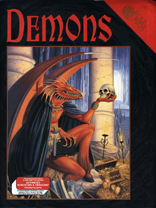 author: Mike Nystul
author: Mike Nystul
interior artists: Tom Sutton, John Hanley, Ken Meyers Jr. & Daniel Gelon
cover artist: Larry Elmore
publisher: Mayfair Games
publication date: 1992
format: folder + 80-page gamemaster's book (no cover), 64-page book "Infernicum Mallemancia" (no cover), 24 loose pages (per Monstrous Compendium), 1 divider and 1 poster map
number of pages: 168
ISBN-10: 0-923763-61-9
ISBN-13: 978-0-923763-61-9
catalog number: Role-Aids 752
description: This product contains 48 demons found in Infernus, a hellish realm of the Demons Campaign Setting. The book is compatible with Advanced Dungeons and Dragons (first edition).
Our featured entry from this bestiary is Grand Decarabria, Prince of the Flesh.
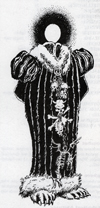 Combat: Decarabria holds an ever-changing assortment of items in each of his hands. In combat, he can change these items into weapons. Each round, the weapons he wields metamorphose into new weapons. To determine his exact armament in any given round, you can make two rolls on the following table:
Combat: Decarabria holds an ever-changing assortment of items in each of his hands. In combat, he can change these items into weapons. Each round, the weapons he wields metamorphose into new weapons. To determine his exact armament in any given round, you can make two rolls on the following table:
| Roll (D6) | Weapon |
| 1 | +4 axe |
| 2 | +3 long sword |
| 3 | short sword, flame tongue |
| 4 | long sword, frost brand |
| 5 | +4 mace |
| 6 | +4 club |
The weapons listed on this table are only exemplary. Many other combinations are possible. If Decarabria is separated from one of his weapons, he can easily create a new one. Separated weapons dissolve into nothingness after 1-8 turns unless a permanency spell is cast on them.
Sphere: Decarabria is the prince of the flesh, charged with the spread of lust.
Diabolical Abilities: Decarabria wields: the lesser ability to shatter (Skill 2 Wizard spell); the standard ability to transmute iron to gold (affects 5 pounds per level of the invoker, or 75 pounds for Decarabria); and the greater ability to raise the dead.
Inquiries: Decarabria truthfully answers queries about the environment.
Role Playing Notes: Decarabria is savage and unforgiving.
Palace: Decarabria's vast palace is located in Thanis.
|
|
|
|
|
September 15, 2018
Demons: Denizens of Vecheron
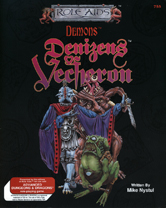 author: Mike Nystul
author: Mike Nystul
editorial director: Ray Winninger
interior artists: Daniel Gelon & Julian Jackson
cover artist: Daniel Gelon
publisher: Mayfair Games
publication date: 1992
format: 32 loose pages + divider + folder
number of pages: 64
ISBN-10: 0-923763-75-9
ISBN-13: 978-0-923763-75-6
catalog number: Role-Aids 755
description: This product contains over 50 demons of the Order of the Heart, which dominate the demi-plane of Vecheron. The book is compatible with Advanced Dungeons and Dragons (first edition).
Our featured entry from this bestiary is Shalphar, the Witch Wife.
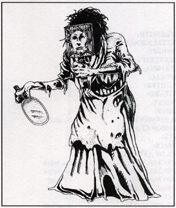 Combat: Shalphar only fights if no other option is left to her. When engaged in melee combat, the hag twists hombly, taking on more traditional demonic features such as claws and horns. She may attack twice per round for 2-8 damage or gore once with her horns for 3-1 8 damage.
Combat: Shalphar only fights if no other option is left to her. When engaged in melee combat, the hag twists hombly, taking on more traditional demonic features such as claws and horns. She may attack twice per round for 2-8 damage or gore once with her horns for 3-1 8 damage.
Diabolical Abilities: The witch wife is so hideous that any mortal that looks upon her directly without protection suffers the effects of a scare spell. Shalphar carries the face of a virgin queen on a stick that she uses as a mask. This face is so lovely that men looking upon it are blinded to the demon's true form. While using the mask, Shalphar can charm men at will...
Pacts: Shalphar prefers the forgotten gifts of estranged lovers and is usually invoked to tempt men to marry without love. Such unions usually end in disaster.
Role Playing: The witch wife's stolen face and her encouraging but empty enticements are so beautiful that she is able to manipulate men quite easily. Unlike the succubi, who tempt with lust, Shalphar tempts men by making them feel more important than they are. Her hand mirror reflects what mortals wish themselves to be and is a useful tool in her machinations.
Palace: Shalphar lives at the top of an impossibly high mountain in a cave guarded by bears with human faces whose claws leave wounds that never heal. She is attended by the souls of those who found true love but could not pursue it because they had married selfishly, following their ambition instead of their heart.
Thanes: Shaphar is attended by Thanes who look like aged crones with sharp talons and tattered wings...
|
|
|
|
|
September 22, 2018
Demons: Denizens of Verekna
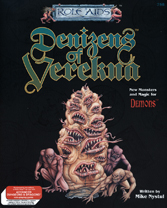 author: Mike Nystul
author: Mike Nystul
editor: Doug Tabb
editorial director: Ray Winninger
interior artists: Corey Barba & Julian Jackson
cover artist: Corey Barba
publisher: Mayfair Games
publication date: 1993
format: 32 loose pages + divider + folder + 16 page pamphlet, "The Grey Grimoire"
number of pages: 64
ISBN-10: 0-923763-80-5
ISBN-13: 978-0-923763-80-0
catalog number: Role-Aids 758
description: This product contains over 50 demons of the Order of the Mind, which dominate the demi-plane of Verekna. The book is compatible with Advanced Dungeons and Dragons (first edition).
Our featured entry from this bestiary is Wrullig, Governor of Forneus.
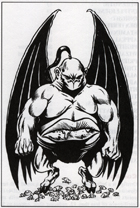 Combat: Wrullig attacks twice per round with his bare hands in melee combat, doing 2-8 points of damage. If he hits the same opponent with both hands they must save vs. death or they are drawn into the grinning orifice in his gut where they suffer an additional 2-20 points of damage. Any mortal who takes more damage than his Stamina from a single gnawing attack is swallowed whole and is deposited into the Infernus with no way back.
Combat: Wrullig attacks twice per round with his bare hands in melee combat, doing 2-8 points of damage. If he hits the same opponent with both hands they must save vs. death or they are drawn into the grinning orifice in his gut where they suffer an additional 2-20 points of damage. Any mortal who takes more damage than his Stamina from a single gnawing attack is swallowed whole and is deposited into the Infernus with no way back.
Diabolical Abilities: The beat of this governor's wings echo the heartbeat of the Infernus, canying him across time and space in the blink of an eye. Once a week he can release a plague of toads on a settlement of any size. The creatures have a voracious appetite and will consume any food they can find until they are destroyed or dispelled.
Pacts: Wrullig will only manifest in a pool of blood, rising from the depths with a newborn's cry. He is seldom called upon by mortal wizards, as he is a known rogue whose actions are dictated more by whim than by the Compact.
Role Playing Notes: No one is sure what Wrullig truly desires or what sin he is meant to embody. He is a mysterious creature who speaks nonsense and follows his own agenda. Encounters with this lord should be brief and enigmatic.
Palace: Wrullig's palace is a hut made of living vines that can entangle the ambition of unwanted visitors, leaving them hopelessly apathetic. He is attended by three ancient spirits who advise him in song.
Thanes: Durullig has power over the trees and can create forests that will devour wayward travellers... Jesarid lurks in the unexpressed rage of the oppressed where he plants the seeds of violence. Ivred-Calar visits the plane prime as a demon storm whose rain poisons the minds of the children of the wicked. Nevvok can move so quickly that he lives two lives. His other form serves Eligos (Duke of the Mind and the Blood) as a warrior of the third circle.
|
|
|
|
|
September 29, 2018
Demons: Denizens of Og
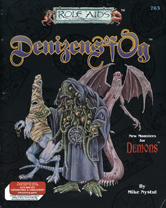 author: Mike Nystul
author: Mike Nystul
editor: Doug Tabb
editorial director: Ray Winninger
interior artist: Tom Sutton
cover artist: Daniel Gelon
publisher: Mayfair Games
publication date: 1993
format: 32 loose pages + divider + folder
number of pages: 64
ISBN-10: 0-923763-95-3
ISBN-13: 978-0-923763-95-4
catalog number: Role-Aids 763
description: This product contains over 50 demons of the Order of the Soul, which dominate the demi-plane of Og. The book is compatible with Advanced Dungeons and Dragons (first edition).
Our featured entry from this bestiary Ammonalin, Governor of Dantalion.
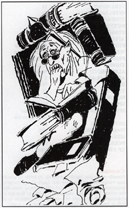 Combat: Ammonalin fights with a withered stave called "desolate fire," a +3 weapon with which he may attack twice per round. The staff does 1-10 points of damage, but its real power is the "lingering doom." If the victim fails a Stamina Check, the next time they sleep they take 2-12 points of damage. A successful save vs. spell will reduce this damage to half. The effects of the doom are cumulative so the demon will tend to concentrate his attacks on a single character until they have suffered the doom at least three times.
Combat: Ammonalin fights with a withered stave called "desolate fire," a +3 weapon with which he may attack twice per round. The staff does 1-10 points of damage, but its real power is the "lingering doom." If the victim fails a Stamina Check, the next time they sleep they take 2-12 points of damage. A successful save vs. spell will reduce this damage to half. The effects of the doom are cumulative so the demon will tend to concentrate his attacks on a single character until they have suffered the doom at least three times.
Diabolical Abilities: Ammonalin can make things of value seem vulgar and give worthless objects the luster of desirability. This power works like a permanent suggestion spell and may be resisted with a successful Insight Check. He may also dispel currency once per turn, destroying all valuables within any radius he chooses up to 5 miles. The wealth of the truly virtuous is unaffected.
Pacts: This Governor can be called upon to inflict the magician's enemies with poverty or to gift his friends with wealth, but the demon will grant no boon directly. He must be summoned in darkness on a carpet of dust with an iron rod which has been dipped in the blood of a noble celebrant. If he chooses to manifest on the plane prime, the virtuous wealthy will weep bitter tears and dark clouds will fill the sky.
Role Playing Notes: There was a time when Ammonalin was summoned so frequently that he tired of interaction with desperate mortals, so he now feigns madness to avoid congress with fools. If the summoner blows three blasts on a silver horn, the demon will drop the act though the mage had best conclude his business quickly lest he rouse the Governor's anger.
Palace: Ammonalin's domain is a shanty town composed of derelict buildings inhabited by lost souls. The towns economy is based on dust, the only commodity available in any supply. Once per day one of the demon guardians leaves a tiny cask in the town square. The Governor delights in watching his charges fight over the few scraps he allows them.
Thanes: Ammonalin's Thanes visit the mortal plane by possessing the hopeless, a service for which they pay thirteen pieces of silver. Jul-garin can fly and trades children for gold. Dathkalon is a master swordswoman who may attack as a skill 11 fighter regardless of what form she takes and works freelance for rich nobleman. Hun-shara sells potion: of delusion which seem to make the imbibers dreams come true though the price is all the character's worldly goods. Wallek-aren speaks in rhyme, casts spells as a skill 7 wizard and may cast charm person and fool's gold at will.
|
|
|
|
|
October 6, 2018
Demons: Denizens of Diannor
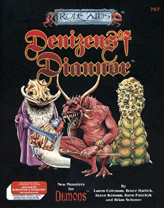 authors: Loren Coleman, Bruce Harlick, Steve Kenson, Dave Panchyk and Brian Schoner
authors: Loren Coleman, Bruce Harlick, Steve Kenson, Dave Panchyk and Brian Schoner
editor: Christopher Kubasik
series editor: Doug Tabb
editorial director: Ray Winninger
interior artist: Alex Niño
cover artist: Dan Gelon
publisher: Mayfair Games
publication date: 1993
format: 32 loose pages + divider + folder
number of pages: 64
ISBN-10: 1-56905-007-4
ISBN-13: 978-1-56905-007-1
catalog number: Role-Aids 767
description: This product contains over 50 demons of the Order of the Blood, which dominate the demi-plane of Diannor. The book is compatible with Advanced Dungeons and Dragons (first edition).
Our featured entry from this bestiary is Pædizar, Governor of Furfur.
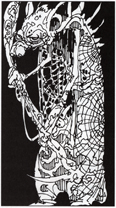 Combat: If Pædizar must fight, his +2 staff does 3-18 points of damage. Additionally, spellcasters struck by the staff are affected as if by a Feeblemind spell, and others by a Confusion spell (saving throws apply).
Combat: If Pædizar must fight, his +2 staff does 3-18 points of damage. Additionally, spellcasters struck by the staff are affected as if by a Feeblemind spell, and others by a Confusion spell (saving throws apply).
Diabolical Abilities: Whenever anyone speaks to Pædizar, the governor immediately knows everything the speaker has ever read, and whether or not each word of it is true. Obviously, Pædizar is immensely knowledgeable, and is often sought by sages and wizards for this reason. Of course, each time such a person summons him, Pædizar learns even more. He can also Detect Lies and has the power of True Seeing (as the priest spells) at will. The GM must adjudicate what information which the demon has at hand, and whether it can answer the needs of the summoner.
Pacts: Pædizar will only respond if the summoner can tell him something he does not already know. The information needs to be worthy of the demon and must be something that he can use later on when bargaining with a mortal.
Role Playing Notes: Pædizar targets those who are proud of how learned they are. He never answers questions directly, replying in cryptic utterances which hint at something far more important than the questioner suspected. Once the Governor has returned home, his thanes set to work, dropping hints and leaving clues to lead the questioner to commit foul deeds in his quest for knowledge better left unknown.
Palace: Pædizar resides at the top of a great grey tower in Diannor. A hundred doors encircle the base, each leading to a winding tunnel strewn with the shredded pages of books of lost knowledge. None of the tunnels leads anywhere.
Thanes: Pædizar's thanes are somber, grey-clad and quiet. They know everything their master knows, and leave clues and puzzles to tempt the unwary into the pursuit of information not meant for mortal minds. Iain cannot see; Ohon cannot hear; Elen cannot speak; Adan cannot move, but is carried around by the others.
|
|
|
|
|
October 13, 2018
To Hell and Back
 author: Nigel Findley
author: Nigel Findley
contributing author: Mike Nystul
editor: Doug Tabb
editorial director: Ray Winninger
interior artists: Julian Jackson, Clip "the Clipper" Art, P. Domain, Joe Devalasco
cover artist: Doré
publisher: Mayfair Games
publication date: 1993
format: box + 38 loose pages + 80-page atlas (no cover) + 64-page guide to Dante's Inferno (no cover) + 5 fold-out maps
number of pages: 182
ISBN-10: 0-923763-62-7
ISBN-13: 978-0-923763-62-6
catalog number: Role-Aids 753
description: This boxed set contains descriptions of thirty-eight monsters and demons. The book is compatible with Advanced Dungeons and Dragons (first edition).
Our featured entry from this bestiary is the Ptolomean.
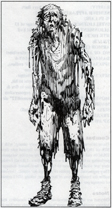 Ptolomeans are the bodies of individuals whose deeds in life were so terribly evil that their souls were pulled to the Nether Realm before they died and replaced by a demon.
Ptolomeans are the bodies of individuals whose deeds in life were so terribly evil that their souls were pulled to the Nether Realm before they died and replaced by a demon.
Combat:
Ptolomeans normally attack with weapons or, particularly if they have dropped their civilized facade, with their long, dirty claws.
Notes: Ptolomeans look exactly like the person they are posing as, and may even try to act as that person did. Over time, however, their appearance will become shabby and their hair and nails will grow long and dirty.
Special: In combat, once the ptolomean's initial HTK points have been reduced to 0, the body it inhabits will drop lifeless to the ground and its demonic spirit will be released. This spirit resembles a humanoid cloud of swirling red mist with glowing eyes. In this form, the ptolomean is immune to sleep, charm, hold, and cold-based spells, can be hit only by +1 or better weapons, and will take 1-8 points of damage from holy water. This spirit will then attack by grabbing its victim and draining 1 level from it. If a victim's levels are reduced below 0, it dies.
Though not truly undead, Ptolomeans are affected by the power of priests and turn as do liches.
Role Playing: Ptolomeans will often try to act as the person, whose body they now possess, acted in life in order to harm others and spread evil. Eventually they will drop this facade and will roam the area attacking people at random.
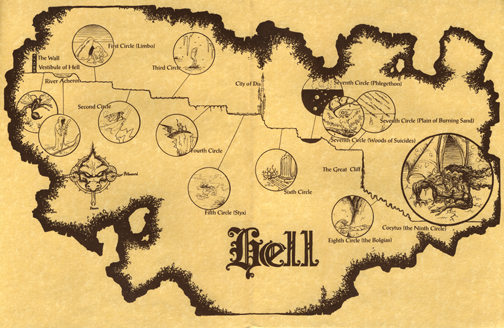
A map of Hell.
|
|
|
|
|
October 20, 2018
Demons: Sentinels
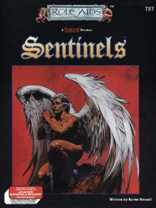 author: Kevin Hassall
author: Kevin Hassall
editor: Doug Tabb
editorial director: Ray Winninger
interior artists: Joe Devalasco & Jespe Myrfors
cover artist: Glenn Fabry
publisher: Mayfair Games
publication date: 1993
format: box + 20 loose pages + 80-page "The Sentinels Sourcebook" (softcover) + 32-page "The Path of Good Intentions" adventure (no cover) + 16-page "A Treatise on Our Divine Aid" illuminated parchment (no cover) +8-page player handout (no cover)
number of pages: 182
ISBN-10: 0-923763-79-1
ISBN-13: 978-0-923763-79-4
catalog number: Role-Aids 757
description: This boxed set contains descriptions of over forty good-aligned creatures. The book is compatible with Advanced Dungeons and Dragons (first edition).
Our featured entry from this bestiary is Ehorael, Attendant & Overseer of the First Dominion Champions.
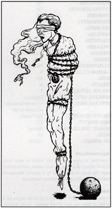 Appearance: Ehorael appears as an androgenous figure who lives out his existence blindfolded and unable to actually see what lies before him (though he could remove the blindfold at any time). Likewise he suffers to be completely chained (though the keys hang from his neck upon a silver chain).
Appearance: Ehorael appears as an androgenous figure who lives out his existence blindfolded and unable to actually see what lies before him (though he could remove the blindfold at any time). Likewise he suffers to be completely chained (though the keys hang from his neck upon a silver chain).
Abilities: Ehorael may prevent any two actions from occurring each round (e.g: deflect two attacks, stop two mortals from moving, etc.). He may also perform True Seeing (as the spell) at whim and may discern the past, present and (likely) future of any person or object in his presence by meditating for one turn. Lastly, Ehorael is immune to all spells of third level or less and 45% resistant to spells fourth through ninth level.
Personality: Ehorael has the most extreme personality of any Sentinel in this Dominion, arguing that inaction is itself a variety of action, so that one must not merely do nothing but should ideally be nothing: its quest towards self-annihilation is one which all of the Champions under his command pursue.
Role Playing: Like all Attendants of the First Dominion, Ehorael is concerned that his actions have no consequences, and so avoids manipulating objects, or engaging in conversation. Unlike the others, however, Ehorael takes this to its extreme, and is as immobile and uncommunicative as his Lord.
|
|
|
|
|
October 27, 2018
Underworld Races and Classes
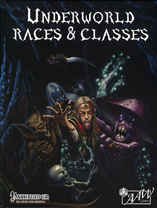 designers: Thilo Graf & Mike Myler
designers: Thilo Graf & Mike Myler
creative director: Jonathan G. Nelson
interior artist: Mates Laurentiu
cover artist: Mates Laurentiu
editors: Chris Harris & Stephen Rowe
publisher: AAW Games
publication date: 2017
format: hardcover
number of pages: 208
ISBN-10: 0-9899736-2-X
ISBN-13: 978-0-9899736-2-5
description: This product contains detailed descriptions of fourteen new playable races suitable for subterranean adventures. The book also includes one chapter with thirteen additional entries in the "Underworld Bestiary". This book is compatible with the Pathfinder roleplaying game.
Our featured entry from this bestiary is the funglet.
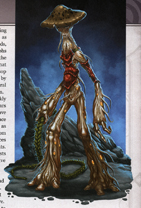 Mushroom Treants of the Underworld
Mushroom Treants of the Underworld
These are the children of the mushroom jungles of the Underworld. They are true children of nature, embracing the fungal forests they call home as though each individual capped stalk growing in the subterranean soil were a cousin or sibling. Philosophers have come to believe that they are the sentient expression of lush Underworld forests, literally made for and by the mushrooms themselves. While they are predominantly loners, a small society of funglets have gathered in Dregharka's Bayou, a fungal jungle bordering the Forever Deep.
History
The fall of the Dracoprime in the Great Schism
presaged the arrival of the funglets in the mushroom
jungles below Aventyr, but their true origins are
disputed both amongst themselves and Underworld
scholars. They aren't a particularly private or
xenophobic race, but their reverent worship of the
subterranean groves that birthed them keep the
funglets from traveling the breadth of the world, and
most folk who even know of the fungal men make no
distinction between their individual beliefs.
Fantasfunglets have deduced that they are the
natural evolution of mushroom life. Acting as the
historians of their race, they place phenomenal
value on reasoning and logical skills--all the
pertinent information at their disposal ultimately
concludes that while some catalyst may or may not
have been present at the time of their appearance
after the Great Schism, they all undeniably are
birthed by a fungal forest.
Audirefunglets believe they are vestiges of the
Dracoprime's life force, carried to the mushroom
jungles by its blood. They refer to the massive
draconic idol as the Natural Force (NG, minor deity)
and refuse to recognize the claims made of its origin
with the Progenitors and their slaves. Instead they
personify it as a deity of their own image, a powerful
force that persists through each of them.
Maculosfunglets worship the oldest living thing
on the planet, the Honningsop Mushroom, as
their patron god and creator. Per their legends,
they were born within the enormous rhizomorphs
of Aventyr's eldest organism, carried across the
Underworld to the many mushroom jungles that
fill its endless caves. Any trace of the Honningsop
is treated with even greater reverence by
maculosfunglets than their kin, but the Natural
Force sees their faith as equally worthy devotion.
However, they came to be, the funglets quickly
spread throughout the Underworld in the years
leading up to and after The Confluence. They have
become the wardens of nature beneath the surface
of Aventyr, respected by all for their services as
caretakers of the exotic, bountiful, mushroom
jungles that provide so many subterranean races
with means to survive the desperate environments.
Were it not for the funglets, the lush fungal forests
throughout the endless caves would never have
prospered into the enormous groves that dot
the Underworld today.
Physical Description: Funglets are a tall and
thin race, typically no shorter than 7 feet in height.
Despite their prodigious size, they are a slight
people and are rather weak given their stature.
There are three types of funglets, each patterned to
have different colors: the fantas are reddish-brown
in complexion (with darker spots), the audires are
colored much like a bright, sprouting flower and the
maculous are a light tannish brown, covered in offyellow
spores. The eyes of these fungal giants are
hooded by the mushroom caps that comprise their
skulls, often casting shadows over their surprisingly
small mouths...
|
|
|
|
|
November 3, 2018
Mordenkainen's Tome of Foes
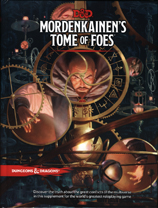 lead designers: Mike Mearls & Jeremy Crawford
lead designers: Mike Mearls & Jeremy Crawford
art director: Kate Irwin
interior artists: Dave Allsop et al.
cover artist: Jason Rainville
managing editor: Jeremy Crawford
publisher: Wizards of the Coast
publication date: 2018
format: hardcover
number of pages: 256
ISBN-10: 0-7869-6624-6
ISBN-13: 978-0-7869-6624-0
catalog number: Role-Aids 757
description: The first 114 pages of this book are comprised of five chapters on the subject of devils and demons, elves, dwarves and duergar, gith and halfling and gnomes. The remainder of the book takes the form of a traditional bestiary. This book is compatible with the fifth edition of the Dungeons & Dragons Role Playing Game.
Our featured entry from this bestiary is the giff.
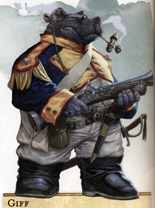 It's easy to spot the giff in a room: a group of 7-foot-tall, hippopotamus-headed humanoids attired in gaudy military uniforms, with gleaming pistols and muskets on display. These spacefaring mercenaries are renowned for their martial training and their love of explosives.
It's easy to spot the giff in a room: a group of 7-foot-tall, hippopotamus-headed humanoids attired in gaudy military uniforms, with gleaming pistols and muskets on display. These spacefaring mercenaries are renowned for their martial training and their love of explosives.
Military Organization. Every aspect of giff society is organized along military lines. From birth until death, every giff has a military rank. It must follow orders from those of superior rank, and it can give orders to those of lower rank. Promotions don't depend on age but are granted by a superior as a reward for valor. Giff are devoted to their children, even as most of their education is geared toward fighting and war.
Mercenaries Extraordinaire. Giff are in high demand as warriors for hire, but they insist on serving in units composed entirely of giff; a giff hiring itself out individually is unheard of. Giff refuse to fight other giff, and will never agree to a contract unless it stipulates that they can sit out a battle rather than wage war against their kin. A giff prizes the reputation of its unit above its own life. Life is fleeting, but the regiment endures for generations or even centuries.
A Whiff of Gunpowder. Muskets and grenades are the favorite weapons of every giff. The bigger the boom, the brighter the flash, and the thicker the smoke it produces, the more giff love a weapon. Their skill with gunpowder is another reason for their popularity as mercenaries. Giff revel in the challenge of building a bomb big enough to level a fortification. They gladly accept payment in kegs of gunpowder in preference to gold, gems, or other currency.
No Honor in Magic. Some giff become wizards, clerics, and other kinds of spellcasters, but they're so infrequent that most giff mercenary units have no magical capability. Typical giff are as smart as the average human, but their focus on military training to the exclusion of all other areas of study can make them seem dull-witted to those who have more varied interests.
|
|
|
|
|
November 10, 2018
Atlas Animalia
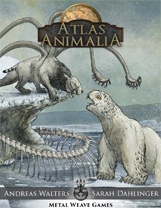 creative director: Andreas Walter
creative director: Andreas Walter
writers: Elizabeth Chaipraditkul, Annamarie Mickey, Kate Bullock, Elizabeth Sander, Carol Darnell & BJ Hensley
interior artist: Sarah Dahlinger
cover artist: Sarah Dahlinger
publisher: Metal Weave Games
publication date: 2018
cover: hardcover
number of pages: 169
ISBN-10: 1-988943-16-7
ISBN-13: 978-1-988943-16-9
catalog number: MWG-AA-01
description: This book contains numerous variations of twenty-five creatures of the traditional fantasy world. This book is compatible any role playing game. Game-specific companion statbooks, including one for the Pathfinder Role Playing Game, were planned, but had not been published by the time this entry was added to the survey.
Our featured entry from this bestiary is the angler hippocampus.
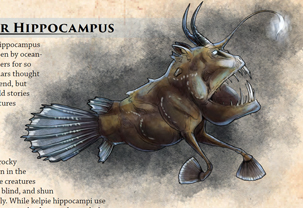 The angler hippocampus remained unseen by ocean and land-dwellers for so long that scholars thought it was pure legend, but sailors have told stories about the creatures for centuries. The angler hippocampus lives primarily in underwater caverns along rocky coastlines. Born in the darkness, these creatures are completely blind, and shun daylight entirely. While kelpie hippocampi use their fins to sense nearby danger, the angler's smaller and more sensitive leg-fins sense changes in water currents in order to navigate cavern tunnels.
The angler hippocampus remained unseen by ocean and land-dwellers for so long that scholars thought it was pure legend, but sailors have told stories about the creatures for centuries. The angler hippocampus lives primarily in underwater caverns along rocky coastlines. Born in the darkness, these creatures are completely blind, and shun daylight entirely. While kelpie hippocampi use their fins to sense nearby danger, the angler's smaller and more sensitive leg-fins sense changes in water currents in order to navigate cavern tunnels.
During my studies, I stumbled upon the ancient tome "Né∂an ahn Díegol" by the gnome druid Andefan. Considered an eccentric by her peers, Andefan would purposefully follow rumors of beasts without any enticement for reward or treasure. Her ventures have been called into question by scholars since her death, but she was the first to illustrate and comment on the angler hippocampus in its deep-sea cavern environment.
Andefan noted that, unlike other hippocampi, the angler variant is a lonely creature from birth. The mare hides her egg in the deepest rock cover along the cavern floor. The egg emits an eerie glow after several weeks, and once entirely lit, the immature hippocampus emerges. The baby's lure entices miniscule organisms until it is capable of hunting, and grows until the angler reaches full maturity, around 3 - 4 feet (1 - 1.2 meters) in length in a span of six months.
Once the angler reaches maturity, it must venture outside its cave at night to attract larger fish. As the creature is not built to expend high amounts of energy in chase, it uses the light of its lure to entice curious prey. Some anglers will hover unmoving for hours before nature rewards them with a meal.
Despite their incredible endurance, I doubt philosophers will write adages extolling the angler hippocampus' patience any time soon.
Rumors & Legends
Alchemists prize the glowing lure of the anglerfish hippocampus as highly as any jewel. Un'wyr, a sea-elf alchemist who worked closely with Andefan, described the creature's lure as "Seduction incarnate in crystalline form; a light which dooms the mind to blind acquiescence." Though it could just be a charlatan's ploy.
|
|
|
|
|
November 17, 2018
Pathways Bestiary
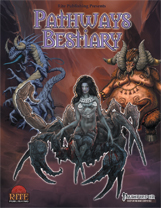 authors: Steven D. Russell with Matt Banach, Johnathan McAnulty,
Will "Cheapy" McCordell, Owen K.C. Stephens, and Mike Welham
authors: Steven D. Russell with Matt Banach, Johnathan McAnulty,
Will "Cheapy" McCordell, Owen K.C. Stephens, and Mike Welham
developer and project manager: Owen K.C. Stephens
interior artists: Juan Diego Dianderas et al.
cover artists: Bruno Balixa, Bob Greyvenstein, and Lance Red
publisher: Rite Publishing
publication date: 2018
cover: hardcover
number of pages: 226
ISBN-13: 237-0-0090-2536-5
description: This book contains sixty creature templates for a fantasy campaign. This book is compatible with the Pathfinder Role Playing Game.
Our featured entry from this bestiary is Mortal Envy, an envious sprite.
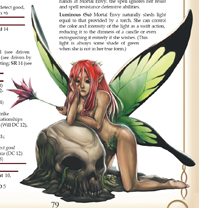 Envy is a sin, and the dark and fell fiends of damnation have ever rewarded sin. These dark powers transform some creatures who earn their attention though their jealousy and malicious intent into envious creatures. Those transformed always take great joy in another's suffering; they lose all sense of kindness they ever possessed. Envious creatures have either a wide-eyed insane look of joy, or a sorrowful and joyless mien; their bodies often take on a greenish hue in some way, shape or form; most often, their eyes take on this color, but not always. Other times they take on the aspect of a dog or a goat...
Envy is a sin, and the dark and fell fiends of damnation have ever rewarded sin. These dark powers transform some creatures who earn their attention though their jealousy and malicious intent into envious creatures. Those transformed always take great joy in another's suffering; they lose all sense of kindness they ever possessed. Envious creatures have either a wide-eyed insane look of joy, or a sorrowful and joyless mien; their bodies often take on a greenish hue in some way, shape or form; most often, their eyes take on this color, but not always. Other times they take on the aspect of a dog or a goat...
Change Shape (Su): Once an envious creature desires a particular object or creature, it can
shapechange at will into the holder of the object or of a second creature that holds the first creature's affections. If anyone calls the envious creature by its true name or actual given name, it is automatically forced back into its natural form for 24 hours. An envious creature's eyes are always green when it assumes a form not its own...
Cursed Relationships (Su): Once per day as an immediate action, an envious can curse a creature within 30 ft. (as bestow curse). That creature must make a successful Will save (DC 10 + 1/2 the envious creature's HD + its Cha modifier) or all NPC interactions are permanently shifted two steps toward the negative.
Spiteful Strike (Su): Envious creatures often believe if they cannot possess something, then no one should. Once per day as a free action, if the envious creature attacks the target of his desire that attack automatically threatens a critical...
Luminous (Su): Mortal Envy naturally sheds light equal to that provided by a torch. She can control the color and intensity of the light as a swift action, reducing it to the dimness of a candle or even extinguishing it entirely if she wishes. (This light is always some shade of green when she is not in her true form.)
|
|
|
|
|
November 24, 2018
Creature Compendium: A Guide to Hunting the Monsters and Creatures of Atheles
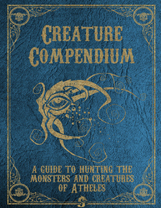 authors: Michael Bielaczyc & Dane Clark Collins
authors: Michael Bielaczyc & Dane Clark Collins
interior artists: Lindsay Archer, Michael Bielaczyc, Paul Bielaczyc, Ethan Black,
Christopher Burdett, Sam Flegal, Melissa Gay, Anna Rogers, Robert Skotak, and Joe Slucher
cover artist: Michael Bielaczyc
publisher: Lone Wanderer Entertainment
publication date: 2018
cover: hardcover
number of pages: 146
ISBN-13: 237-0009210938
description: This bestiary contains ninety-six creatures native to lands of Atheles. This book is compatible with the Dark Return, SagaBorn Role Playing Game.
Our featured entry from this bestiary is the merfolk.
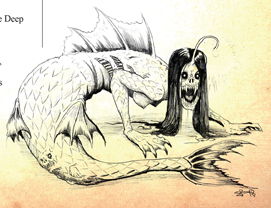 Sailors speak of beautiful mermaids calling to them to join them. Myths of the merman who left the sea to marry the Queen of the northern kingdoms are still told to children.
Sailors speak of beautiful mermaids calling to them to join them. Myths of the merman who left the sea to marry the Queen of the northern kingdoms are still told to children.
This, however, is not the truth behind the merfolk. They are actually monsters, a predatory race of aquatic beings who feed on land dwellers. They use any means possible, altering their appearance to seem beautiful and desirable, or using their strange ghostly light to lure their victims into the depths.
They look like the deep sea fishes that wash up on shore, with large milky eyes and giant mouths filled with transparent teeth. Many a sailor has fallen to the lure of their embrace, only to find themselves torn apart and eaten alive by the object of their desire.
|
|
|
|
|
December 1, 2018
In the Company of Dragons Expanded
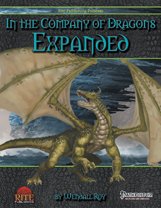 author: Wendall Roy
author: Wendall Roy
guest authors: Steve Russell, Jason Nelson, Ben McFarland, & Jeremy Smith
interior artists: Tiger Myuou, Trungth, Xiphoid Lies et al.
cover artists: Eric Quigley & Tacosauceninja
publisher: Rite Publishing
publication date: 2018
cover: hardcover
number of pages: 198
ISBN-13: 237-0007940417
description: This book contains a complete set of information necessary for a player character to be of the race of dragons. This book is compatible with the Pathfinder Role Playing Game.
Our featured entry from this book is the lung dragon.
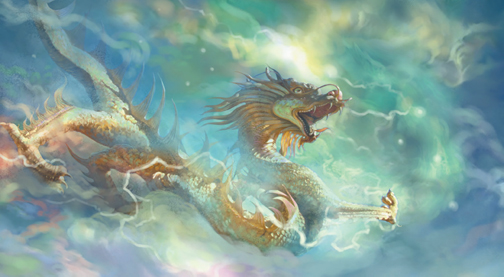
It should be noted that we breed true with our cousins from the material plane. Eggs which are raised and hatched in the Lost Isles under the auspice of Our Lady of the Rainbow Scales will emerge as a taninim, while an egg which develops in the world of the ephemerals will be one of our cousins that you refer to as "true" dragons.
There are two exceptions among us taninim. The first is the Organizers, a particular bloodline of my people with unique physical appearance and worldview. Even the most chaotic and unfettered member of this bloodline views everything as having a unique place and purpose in the world to
them, and it is unnerving to them to see a creature acting against what they see as its place in reality or an item perverted from its purpose. The Organizers, also called Lung from an ephemeral title given to the first of the bloodline that explored your world, are wingless creatures whose bodies are more serpentine than the rest of us. As they gain in power, they grow elaborate horns and feathery hair around their muzzle and joints. Some even grow a luminescent pearl-like structure on their foreheads the Lung call a third eye. Legend claims the bloodline came about when one of the first taninim, in a fit of hunger, attacked a great spirit clam. This was a taboo act, as the spirit clam was one of a handful of sage spirits that anchored meaning to reality. The taninim eventually tore open and consumed the clam, but not before having both his wings ripped off in the struggle. A curse settled upon the taninim after his meal, for he had consumed the spirit clam's magical pearl that was the core of its power. He was forever after obligated to carry out the spirit clam's mandate of organizing the world.
|
|
|
|
|
December 8, 2018
Sandy Peterson's Cthulhu Mythos
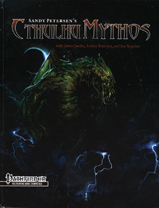 authors: Sandy Petersen, James Jacobs, Arthur Petersen and Ian Starcher
authors: Sandy Petersen, James Jacobs, Arthur Petersen and Ian Starcher
interior artists: Kent Hamilton & Richard Luong
miniature painters: Avalon (Starcher) Zalinski, Ian Phillips, Roy Duffy & Chris Ewick
miniature photographer: Sheri Starcher
cover artist: Kent Hamilton
publisher: Petersen Games
publication date: 2018
cover: hardcover
number of pages: 498
ISBN-10: 0-9995390-0-0
ISBN-13: 978-0-9995390-0-2
description: This book contains all manner of resources for a campaign based on the writings of H.P. Lovecraft. Of relevance to this survey are Chapter VIII. Great Old Ones and Outer Gods, Chapter IX. Mythos Bestiary & Chapter X. Expanded Mythos Bestiary, which collectively run 295 pages. This book is compatible with the Pathfinder Role Playing Game.
Our featured entry from this bestiary is an outer abomination, a Child of the Outer Gods.
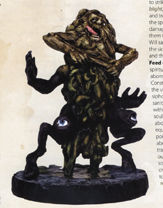 Children of the Outer Gods
Children of the Outer Gods
Humanity was not meant to delve deeply into the eldritch secrets of the Mythos. While madness and insanity are the typical result of curiosity and exploration into these nightmare topics, some of the most fecund or contagious elements of the Mythos, such as experiments involving past life regression, certain transformative mutagens crafted by the serpentfolk, or the mere presence of Shub-Niggurath can cause twisting and distortion in the flesh as surely as the mind. These events can give rise to the vile and terrible transformations that warp curious unfortunates into outer mutants. Perhaps the most revolting method by which such monstrosities come to be lies with interbreeding between alien monstrosities and humanity. In some cases, the results of such crossbreeding are relatively stable, as in the case of the deep one hybrid or the satyr, but in most cases, particularly those involving impregnation via one of the Great Old Ones or Outer Gods, the result is always one of teratological terror.
Children of the Elder Beings are usually around human size, though they trend toward the larger end of the scale. In Lovecraft's tale The Dunwich Horror, the interdimensional entity Yog-Sothoth fathers two children upon a wizard's daughter. One of the children is able to pass for human, at least when wearing long pants and shirts that button up to the neck and wrists, though there is still obviously something wrong (at the age of 12, he stood 7 feet tall). The other child is an oft-invisible mix of tentacles and conjoined limbs bigger than an elephant.
These entities fall into three broad categories. First are the outer mutants, representing those hybrids in which the human side features most prominently. The outer spawn represent the other end of the spectrum: for instance, the colossal insect/octopus thing that appears at the end of The Dunwich Horror. Outer abominations fall between these two extremes into a sort of intermediate stage. Children of the Elder Beings often progress inevitably through these stages,
from mutant to abomination to spawn, the transitions marked by awful trauma and burgeoning evil.
There is more to these beings than grotesque monstrosity. The Outer Gods spawn them not out of whim but to a purpose, and often a terrible one. Yog-Sothoth and the other Outer Gods seek constantly to break through into mortal planes for unthinkable purposes. These entities contact humans and other races (and can be contacted in return), and often mingle their own vile heritage with lesser beings. The
result, in every case, is a distorted monstrosity, varying greatly in power and size.
This is the fundamental truth behind the outer mutants, abominations, and spawns: they constantly plot, scheme, and work toward opening gateways to bring the Outer Gods to the world to rule again and bring about the final apocalypse...
Outer Abominations
Every outer abomination is unique. However, in general they are still clearly derived from a humanoid form and are still in the process of eternal change. They have a face that buds from or is embossed upon some part of their upper body, and they usually still have hands and legs of a sort. Their evolving bodies often leave their inner organs open to the air, and they sprout tentacles or spawning sacs.
Outer abominations, like outer mutants and outer spawn are mortal/outside hybrids, descended from profane and perverse unions with Outer Gods.
When these offspring reach the abomination stage of development, they can no longer pass for mortal
creatures and grow quite large-up to 12 feet in height and a ton or more in weight.
Abominations are the "second level" of horror resulting from an Outer God producing offspring with a mortal creature. They are significantly larger and more physically powerful than outer mutants, with potent mental and magical abilities. However, their minds are far more alien than those of the comparatively tractabIe mutant and they rarely work well with humans, let alone lead them. Rather, cults tend to treat them more as objects of worship at best or dangerous guardian beasts at worst.
At the abomination stage, the creature can no longer pass as a normal person: their hideous malformations are plain to all. They still feed on blood and soul energy, as mutants do, but they require much larger quantities and typically drain victims dry, rather than just tapping a target for a few pints at a time. Cults often use abominations as a convenient means to sacrifice victims to their Outer God master (usually but not always the abomination's parent), since they cannot afford to let the abominations feed on their numbers. An abomination grows steadily until eventually it can transform itself into an Outer Spawn.
|
|
|
|
|
December 15, 2018
Alien Archive 2
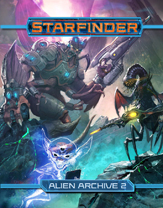 development leads: Joe Pasini, Chris Sims & Owen K.C. Stephens
development leads: Joe Pasini, Chris Sims & Owen K.C. Stephens
authors: Alexander Auguras et al.
interior artists: Alexandur Alexandrov et al.
cover artist: Remko Troost
publisher: Paizo Publishing
publication date: 2018
cover: hardcover
number of pages: 160
ISBN-10: 1-64078-075-0
ISBN-13: 978-1-64078-075-0
catalog number: PZO7109
description: This book contains one-hundred lifeforms for a science fiction based campaign. This book is compatible with the Starfinder Role Playing Game.
Our featured entry from this bestiary is the glitch gremlin.
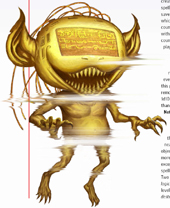 Gremlins are fey spirits intimately tied to technological malfunctions. One variety of gremlin, called glitch gremlins, is especially common (and feared) in societies with advanced technology. Both computer glitch gremlins and ship glitch gremlins demonstrate remarkable single-mindedness in their pursuit of mayhem as they find new and more frustrating ways to make technology break, glitch, or fail.
Gremlins are fey spirits intimately tied to technological malfunctions. One variety of gremlin, called glitch gremlins, is especially common (and feared) in societies with advanced technology. Both computer glitch gremlins and ship glitch gremlins demonstrate remarkable single-mindedness in their pursuit of mayhem as they find new and more frustrating ways to make technology break, glitch, or fail.
A computer glitch gremlin's appearance varies widely with the digital data it has eaten, but they average 1 foot in height and weigh around 4 pounds...
Digital Telepathy (Su) A computer glitch gremlin can communicate telepathically only with digital devices and with other creatures that can do so (such as other computer glitch gremlins). This allows the glitch gremlin to attempt Computers checks to access any computer within the telepathy's range.
Glitch Module (Su) When a glitch gremlin succeeds at a Computers check to access a system or hits a foe with an attack or spell, the accessed system or one random computer held or carried by the struck creature glitches...The glitch causes one of the following effects, which functions as if the system had the indicated countermeasure: a fake shell countermeasure that obstructs all users, an alarm that plays a loud and potentially embarrassing audio or holographic file when accessed by any user unless the user succeeds at a Computers check as if hacking the system, or one randomly determined countermeasure that applies even to users with root access. Disabling or removing this glitch requires a Computers check as if disabling or removing a module. A disabled glitch reactivates after 1d10 minutes if not removed. A system can have no more than one glitch per module.
|
|
|
|
|
December 22, 2018
Creature Codex
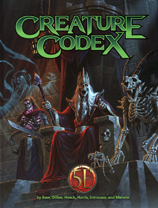 designers: Wolfgang Baur et al.
designers: Wolfgang Baur et al.
interior artists: Gabriel Cassata et al.
cover artist: Craig J. Spearling
publisher: Kobold Press (Wolfgang Baur)
publication date: 2018
cover: hardcover
number of pages: 420
ISBN-10: 1-936781-92-1
ISBN-13: 978-1-936781-92-8
description: This book contains nearly 400 creatures. This book is compatible with 5th edition Dungeons & Dragons Role Playing Game.
Our featured entry from this bestiary is the flame-scourged scion.
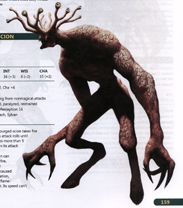 This tree-like creature's hide is charred, cracked, and oozing. A crown of long, branching tentacles set with goat-like eyes encircles a central fanged maw at the top of its bulk. Root-like appendages end in blackened, sooty hooves.
This tree-like creature's hide is charred, cracked, and oozing. A crown of long, branching tentacles set with goat-like eyes encircles a central fanged maw at the top of its bulk. Root-like appendages end in blackened, sooty hooves.
Born of Burned Groves. During a great scourge that broke the power of a dark goddess' followers and the power of mages who worshiped her, crusaders destroyed her unholy groves. Her loyal followers and guardians were slain and the groves were razed with holy fire. All the unholy trees of those vile groves burned, as did the profane offspring of the dark goddess. However, not all that were burned died. The strongest of her children lived, and they remain as guardians of those lost places of power. Their might has warped and changed but it is hardly diminished.
Unholy Trees. Flame-scourged scions often lurk in their unholy mother's groves in tree form. Where once they would take the shape of living trees, now they appear as leafless, charred husks, to lend in with the hardscrabble nature of these desolate areas.
|
|
|
|
|
December 29, 2018
The Bestiary of Equestria
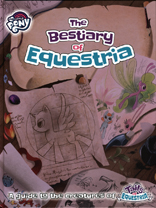 author: Jack Caesar
author: Jack Caesar
interior artists: Amy Mebberson, Anna Sep, Matthew Incorvati et al.
cover artist: Amy Mebberson
publisher: Shinobi7 & River Horse Games
publication date: 2018
cover: hardcover
number of pages: 124
ISBN-10: 1-62692-625-5
ISBN-13: 978-1-62692-625-7
description: This book contains over seventy creatures for a campaign based on My Little Pony. This book is compatible with the Tails of Equestria Role Playing Game.
Our featured entry from this bestiary is the power pony, Fili-Second.
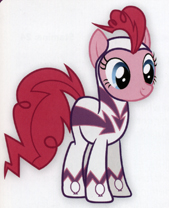 Talents: Stout Heart, Nimble
Talents: Stout Heart, Nimble
Quirks: Short Attention Span, Secret Identity
Special: Fili-second can travel long distances extremely quickly. The limits of this power are up to the GM but can generally be used to dodge past foes, run up the side of buildings, and even outrun a speeding train!
Fili-second is the fastest pony in all of Maretropolis--in the blink of an eye, she can zip a distance of miles in a mere second, moving so quickly that she leaves behind her a trail of pulsing pink energy. She delightsin using this power to utterly confuse her enemies.
|
|
|
|
|
Continue to late addition (2019) entries.
|
|
|
|
|
|
|
|

